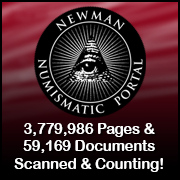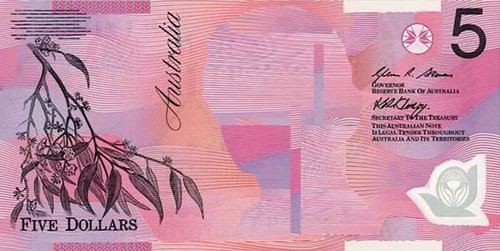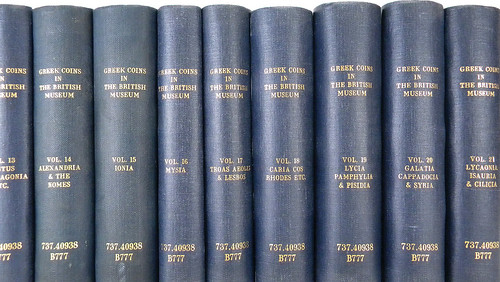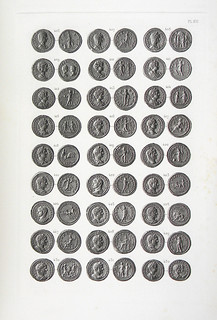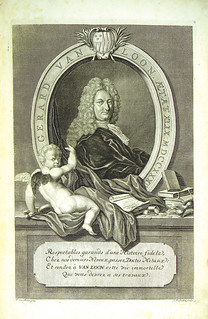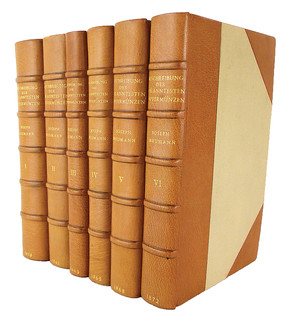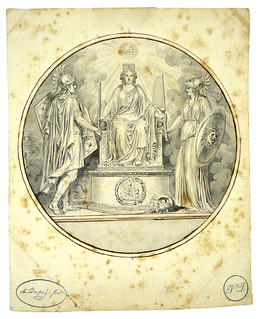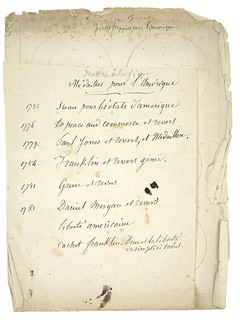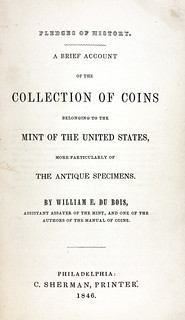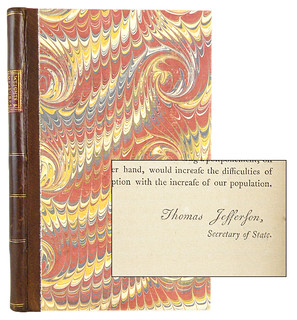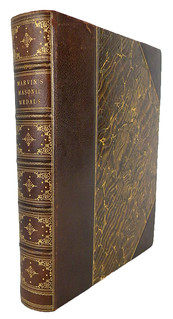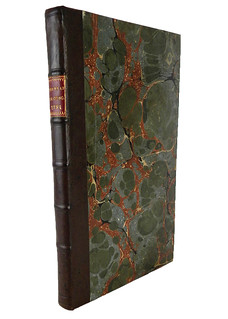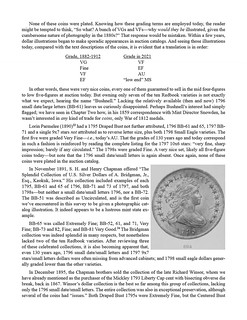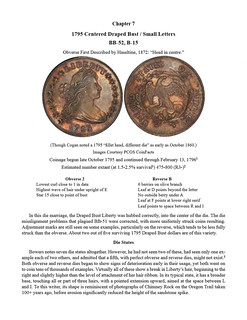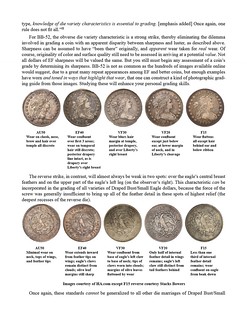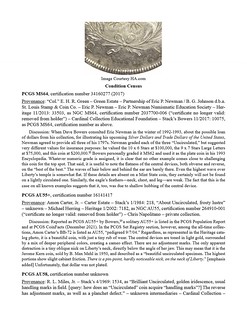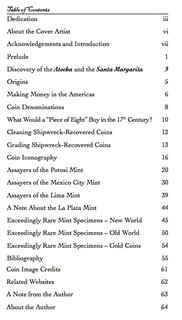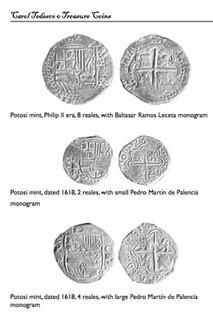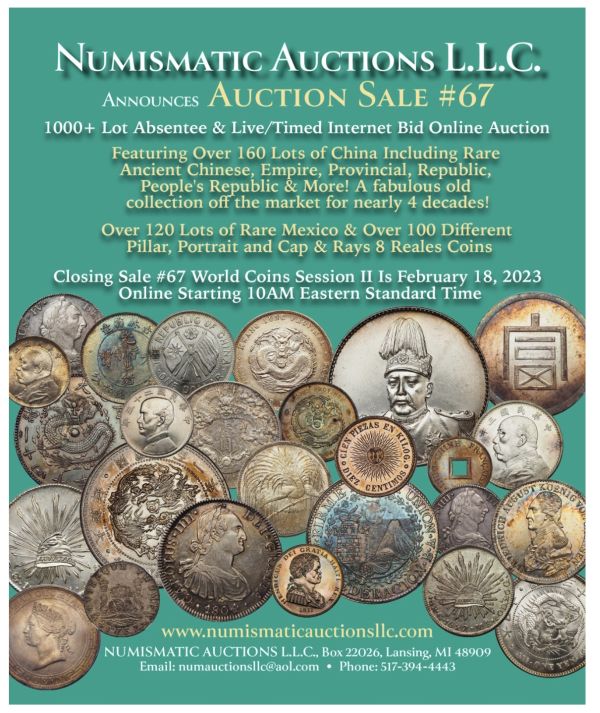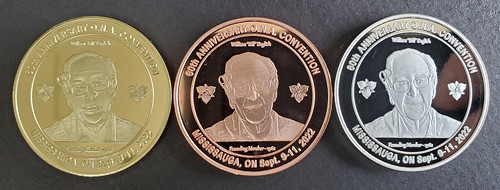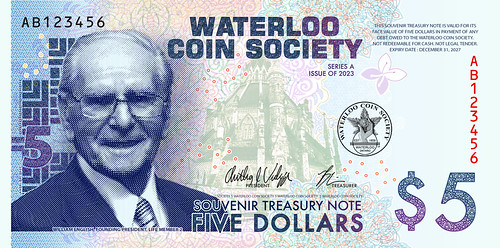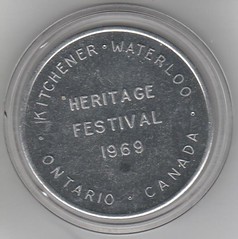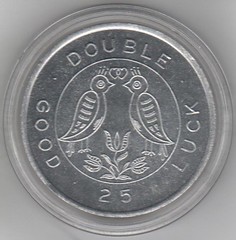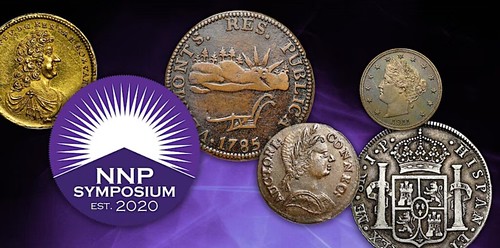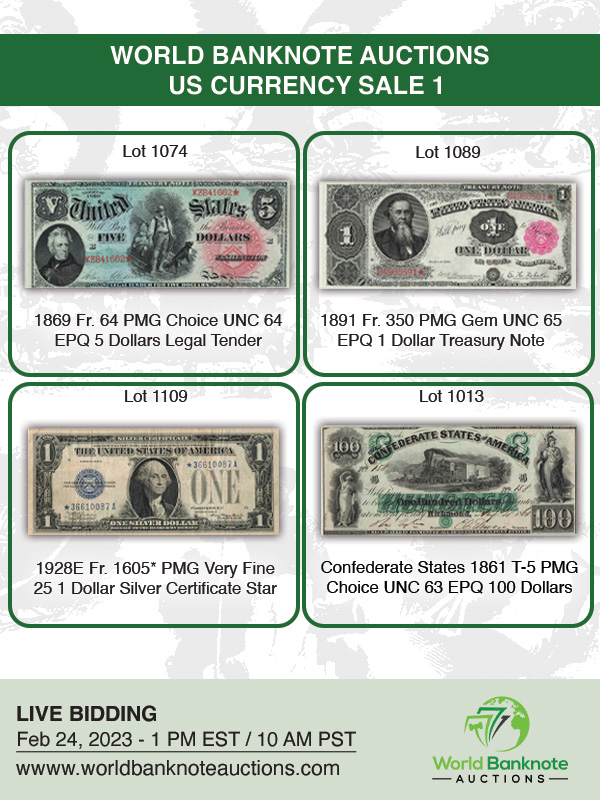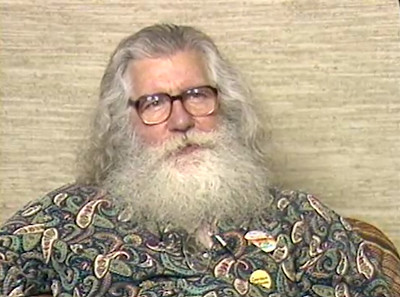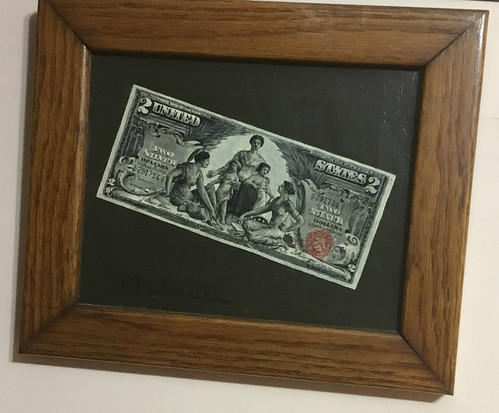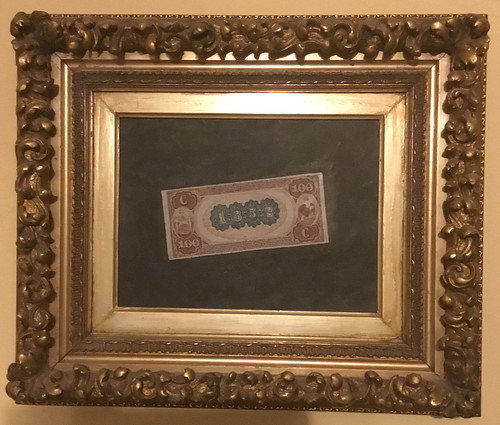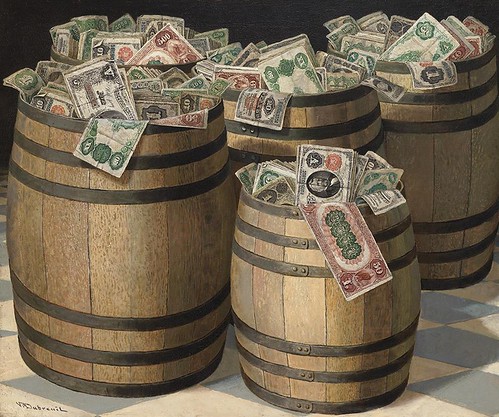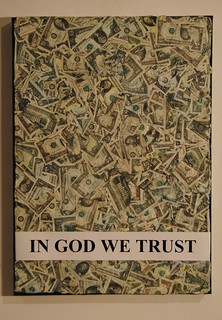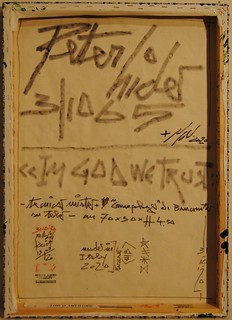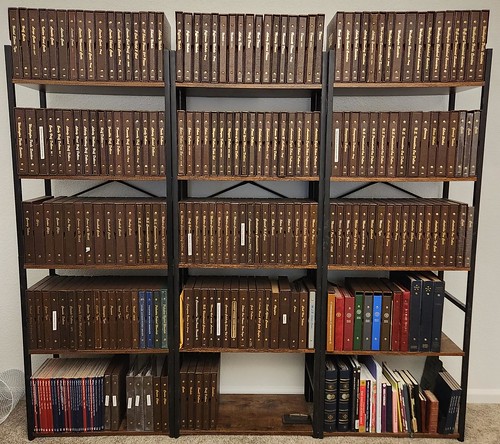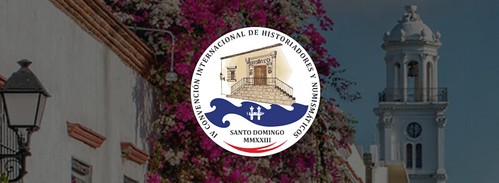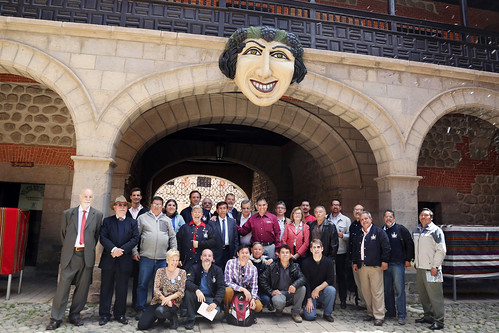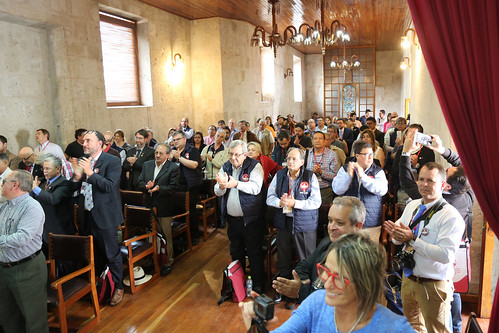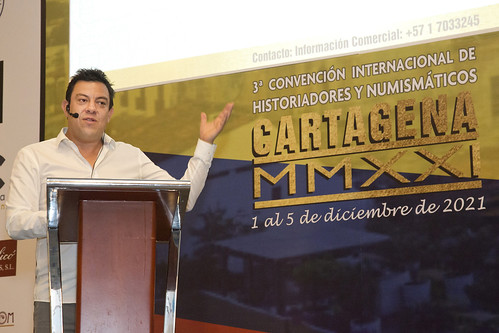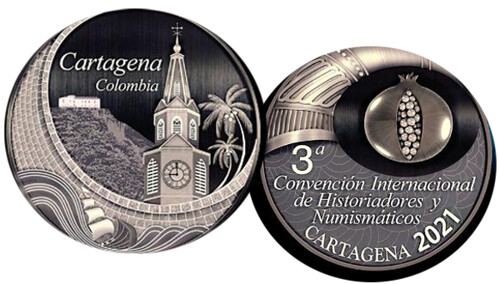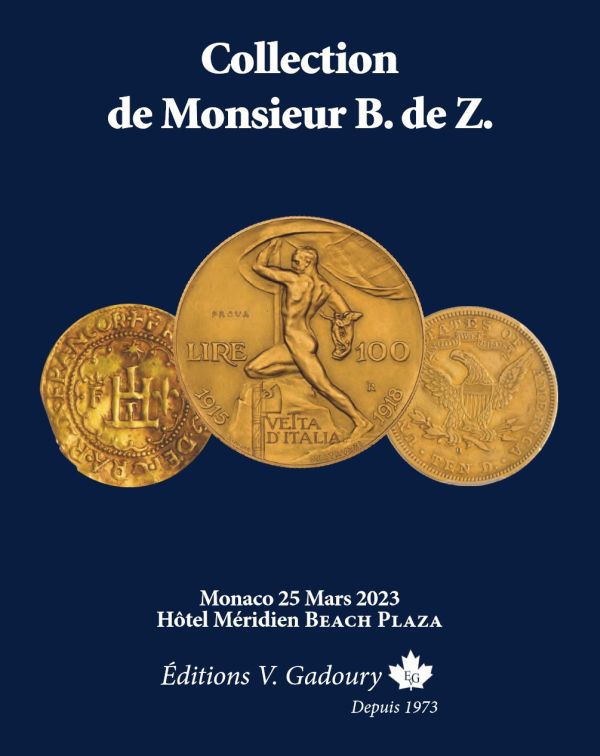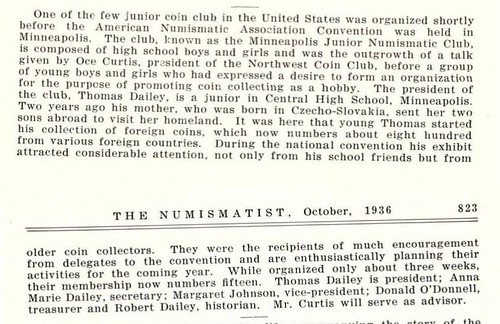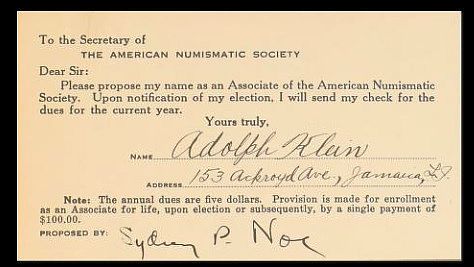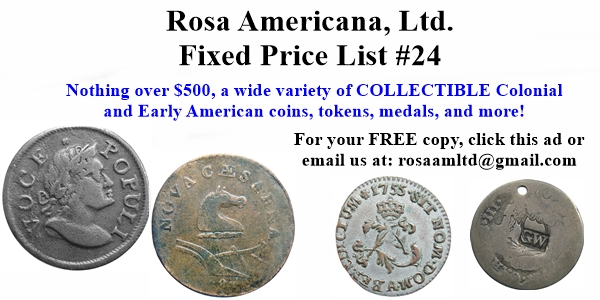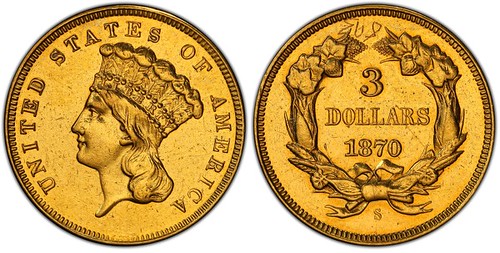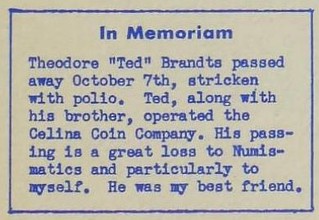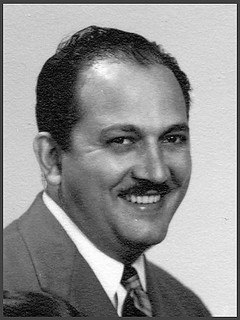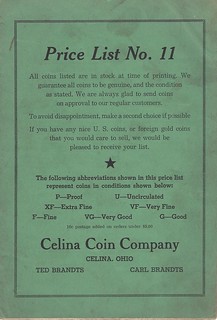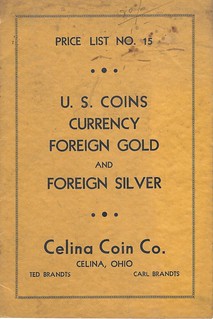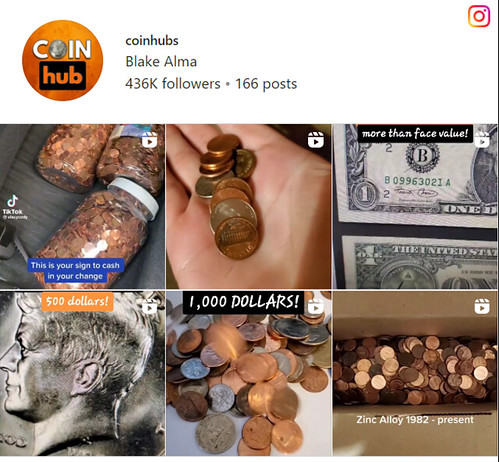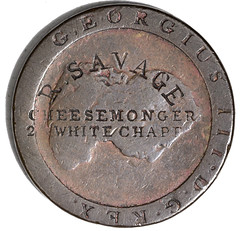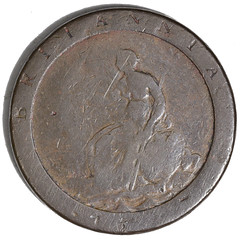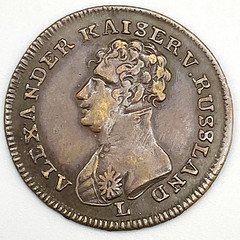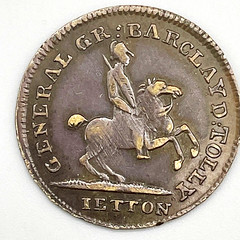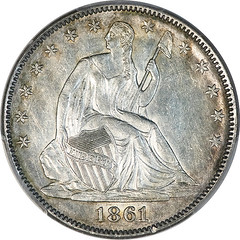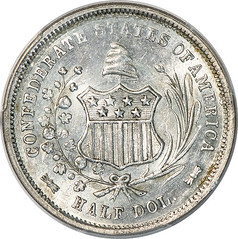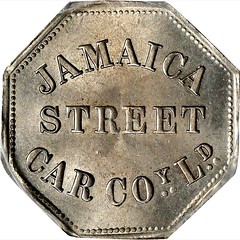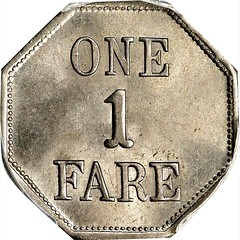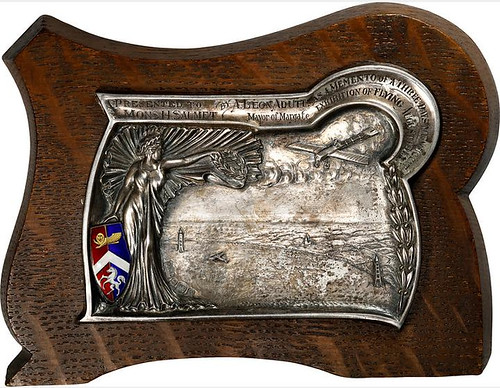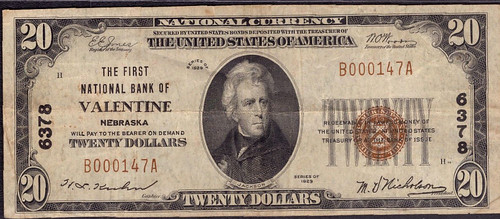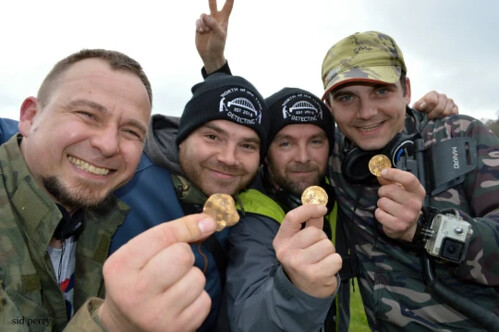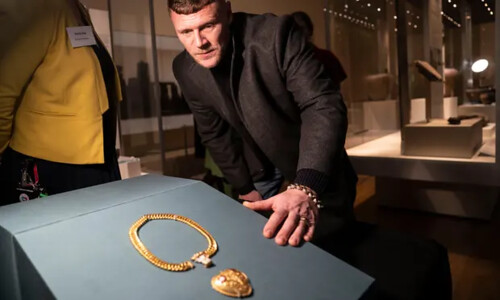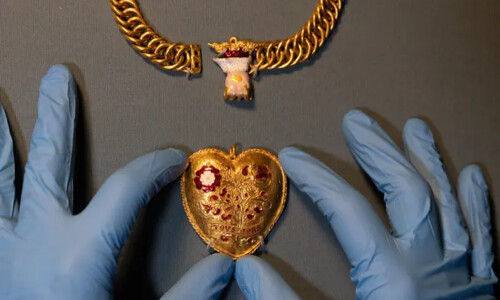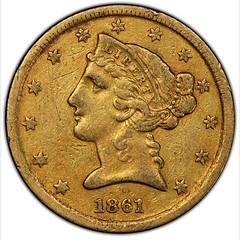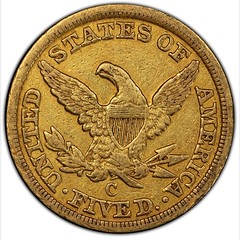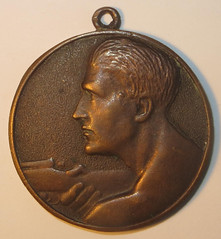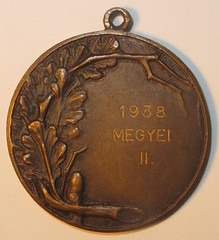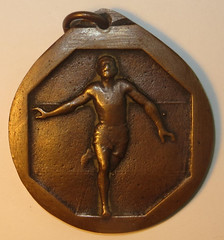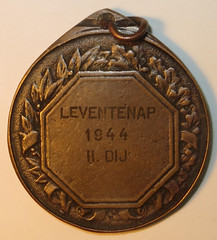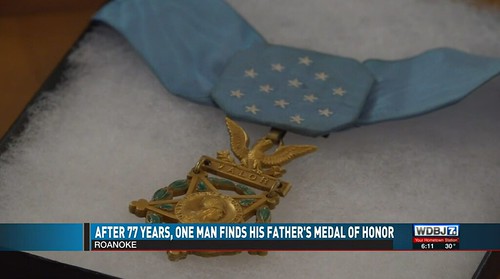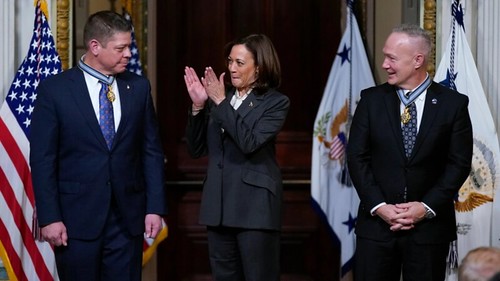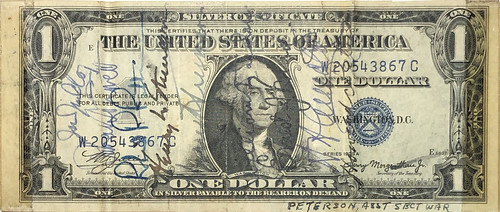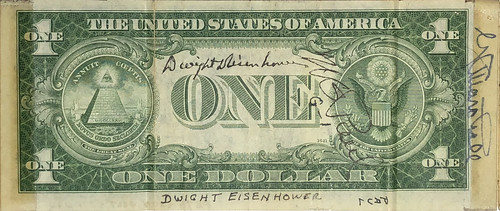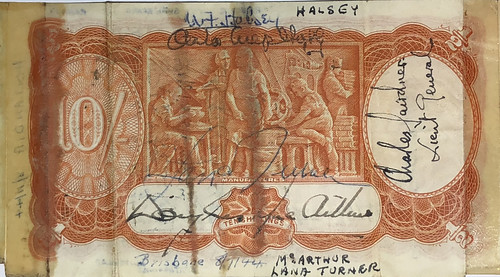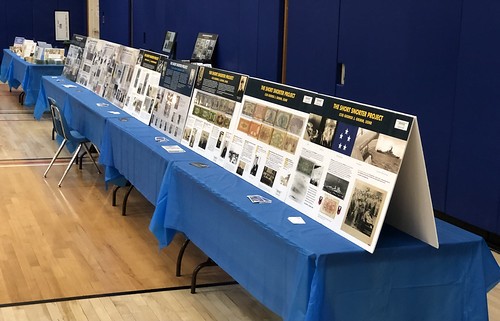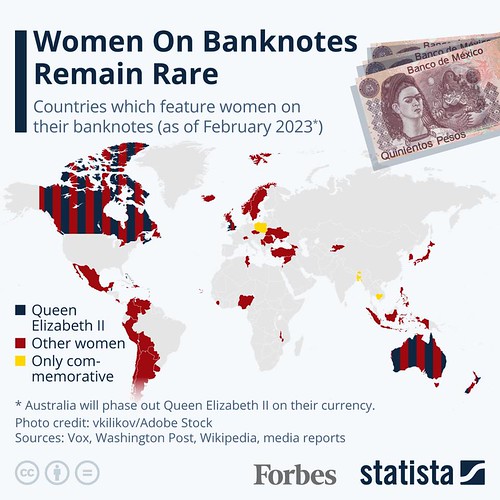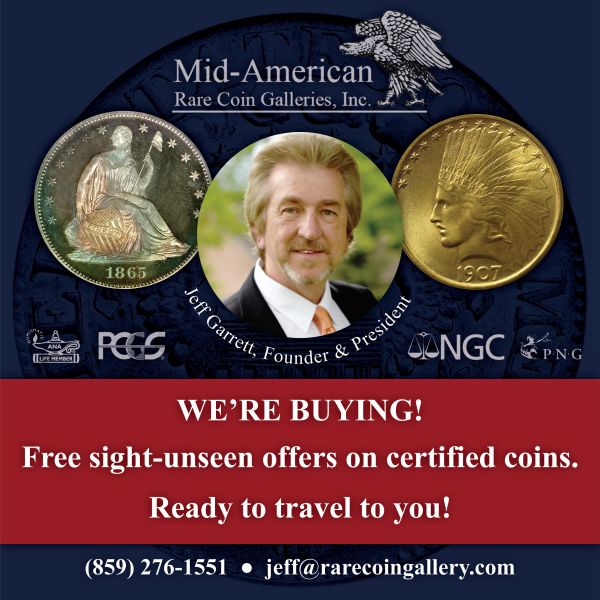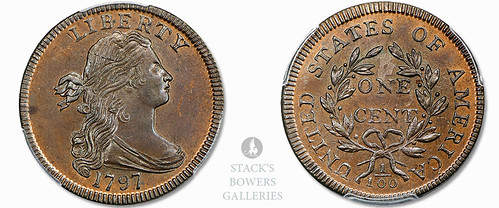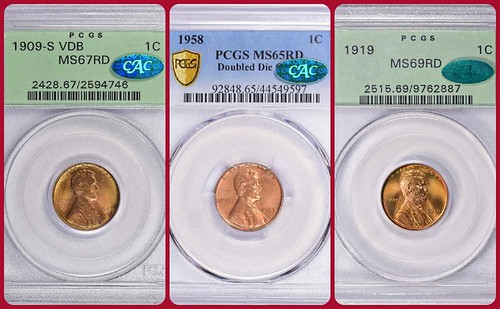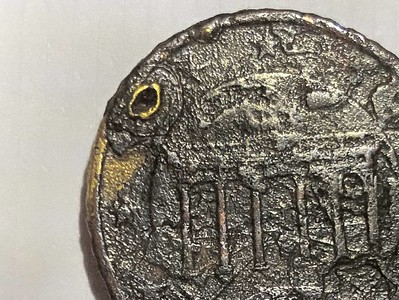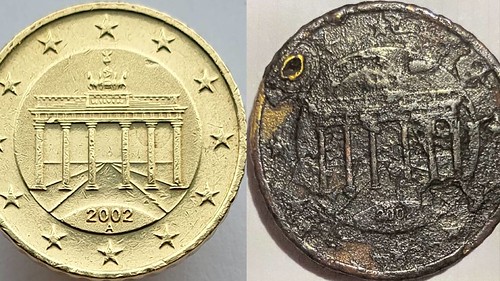
Visit our NBS Sponsors




About UsThe Numismatic Bibliomania Society is a non-profit association devoted to the study and enjoyment of numismatic literature. For more information please see our web site at coinbooks.org SubscriptionsThose wishing to become new E-Sylum subscribers (or wishing to Unsubscribe) can go to the following web page link MembershipThere is a membership application available on the web site Membership Application To join, print the application and return it with your check to the address printed on the application. Print/Digital membership is $40 to addresses in the U.S., and $60 elsewhere. A digital-only membership is available for $25. For those without web access, write to: Charles Heck, Treasurer AsylumFor Asylum mailing address changes and other membership questions, contact Chuck at this email address: treasurer@coinbooks.org SubmissionsTo submit items for publication in The E-Sylum, write to the Editor at this address: whomren@gmail.com BUY THE BOOK BEFORE THE COINSale Calendar |
- WAYNE'S WORDS: THE E-SYLUM FEBRUARY 5, 2023
- KOLBE & FANNING AUCTION SALE 166 ANNOUNCED
- NEW BOOK: EAGLE POISED ON A BANK OF CLOUDS
- NEW BOOK: TREASURE COINS 2022 ANNIVERSARY EDITION
- NEW BOOK: UNTANGLING THE RECORD
- IAPN BOOK NOMINEE: NUMISMATICS FOR EVERYONE
- CANADIAN COLLECTOR BILL ENGLISH TURNS 100
- 2023 NEWMAN GRANT PROGRAM ANNOUNCED
- APRIL 2023 NNP SYMPOSIUM ANNOUNCED
- VIDEO: WALTER BREEN
- MORE MONEY ART: VICTOR DUBREUIL, PETER HIDE
- NOTES FROM E-SYLUM READERS: FEBRUARY 5, 2023
- SANTO DOMINGO MMXXIII CALL FOR PAPERS
- VOCABULARY TERM: MINT SET
- MORE ON JUNIOR COIN CLUBS
- THE CELINA COIN COMPANY
- BLAKE ALMA'S COINHUB
- NUMISMATIC NUGGETS: FEBRUARY 5, 2023
- HAMBLEDEN HOARD DECLARED TREASURE
- EARLY TUDOR GOLD PENDANT FOUND
- ANCIENT COIN COLLECTORS GUILD RESPONDS TO THREATS
- CHARLOTTE MINT UNDER CONFEDERATE CONTROL
- HUNGARIAN LEVENTE MEDALS
- WWII MEDAL OF HONOR RETURNED
- SPACEX ASTRONAUTS GET SPACE MEDAL OF HONOR
- SHORT SNORTER EXHIBIT COMING TO PHOENIX
- WOMEN ON BANKNOTES REMAIN RARE
- AUSTRALIAN CURRENCY WON'T FEATURE KING
- LOOSE CHANGE: FEBRUARY 5, 2023
- MYSTERIOUS ANCIENT COIN FOUND IN AUSTRALIA
Click here to read the thin version on the web
Click here to subscribe
Click here to access the complete archive
To comment or submit articles, reply to whomren@gmail.com
Content presented in The E-Sylum is not necessarily researched or independently fact-checked, and views expressed do not necessarily represent those of the Numismatic Bibliomania Society.
WAYNE'S WORDS: THE E-SYLUM FEBRUARY 5, 2023
 New subscribers this week include:
Sheridan Downey,
Daniel Gerken,
Thomas Sparks,
Carol Tedesco, and
Sven Martzinek.
Welcome aboard!
New subscribers this week include:
Sheridan Downey,
Daniel Gerken,
Thomas Sparks,
Carol Tedesco, and
Sven Martzinek.
Welcome aboard!
Thank you for reading The E-Sylum. If you enjoy it, please send me the email addresses of friends you think may enjoy it as well and I'll send them a subscription. Contact me at whomren@gmail.com anytime regarding your subscription, or questions, comments or suggestions about our content.
This week we open with a new numismatic literature sale, three new books, a new centenarian numismatist, updates from the Newman Numismatic Portal, reader comments, and more.
Other topics this week include treasure coins, the IAPN book awards, the NNP Symposium, money art, Mint sets, Junior coin clubs, the Celina Coin Company, CoinHub, coin hoards and detectorist finds, the Medal of Honor and the Space Medal of Honor, Short Snorters and a mysterious ancient coin.
To learn more about Greek Coins in the British Museum, the U.S. silver dollars of 1795-1798, Potosi and Lima Mint coins, Bill English, Walter Breen, Blake Alma, the 4th International Convention of Historians and Numismatists, cheesemongers, the Hambleden hoard, the Nichols hoard, Hungarian Levente medals, and short snorters, read on. Have a great week, everyone!
Wayne Homren
Editor, The E-Sylum
KOLBE & FANNING AUCTION SALE 166 ANNOUNCED
Kolbe & Fanning have announced their next numismatic literature sale. Another stellar offering of material, many both rare and important. -Editor
Kolbe & Fanning February 25 Sale
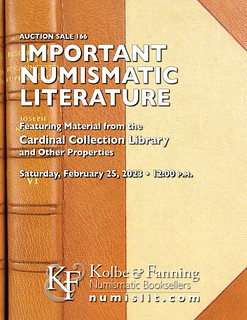
Kolbe & Fanning Numismatic Booksellers are pleased to announce that we will be holding our next auction sale on Saturday, February 25, 2023. The sale includes a remarkable variety of rare and out-of-print works on coins, medals, and paper money from antiquity to the present, combining selections from an impressive library on world coins with further selections from the extraordinary Cardinal Collection Library.
Some highlights of the sale include:
Lot 14: a complete set of A Catalogue of Greek Coins in the British Museum, the 29-volume classic reference
Lot 66: the 1887 Rollin & Feuardent catalogue of the collection of Roman and Byzantine gold coins formed by Gustave, Viscount de Ponton d'Amécourt
Lot 187: an original set of the 1732–1737 French edition of Gerard van Loon's magnificent five-volume compendium of medals relating to Dutch history
Lot 207: a complete set of Josef Neumann's 1858–1872 encyclopedia of copper coins of the world, beautifully bound in six volumes by Sangorski & Sutcliffe
Lot 245: a finely rendered original drawing in pencil by Augustin Dupré to mark the attack on the Tuileries on August 10, 1792
Lot 247: a unique manuscript outline by Narcisse Dupré, son of Augustin, listing medals relating to the United States designed by his father
Lot 334: the very rare Pledges of History, the first catalogue of the cabinet of coins belonging to the United States Mint, by Assistant Assayer William E. Du Bois
Lot 382: Thomas Jefferson's 1790 Report on Weights, Measures and Coins of the United States, a landmark work in the development of the U.S. monetary system, written by Jefferson while Secretary of State under Washington
Lot 410: Virgil Brand's handsomely bound copy of W.T.R. Marvin's rare study of The Medals of the Masonic Fraternity (1880), accompanied by the later supplement
Lot 477: the original printing of the Journal of the Senate for 1791–1792, including An Act Establishing a Mint, and Regulating the Coins of the United States, the foundation of all U.S. coinage.
Register early to bid online
Bids may be placed via post, email, fax or phone, as well as online. Kolbe & Fanning use Auction Mobility as our third-party online bidding platform. Auction Mobility is an app-based platform allowing users the ability to participate in the sale through phones, tablets and computers. To register for the sale, bidders must go to bid.numislit.com and sign up. Once you have set up an account, you may browse lots, place advance bids, or participate in the live sale online. Those wishing to participate on their devices can download the Kolbe & Fanning app through the Apple or Google Play Store. The sale will also be listed on Biddr and NumisBids in the near future.
The printed catalogue has been mailed to all active customers on our mailing list. As international mail speeds have been inconsistent, we encourage our foreign clients to consult the electronic catalogue in case their printed catalogue does not arrive promptly. A PDF of the printed catalogue has been posted to our main website at numislit.com for those who prefer that format. Bids placed via post, email, fax or phone must be received by February 24, the day before the sale, in order for them to be processed. Advance absentee bids may also be placed at any time online at bid.numislit.com. Live internet bidding will be available during the sale itself through the same platform.
Kolbe & Fanning Numismatic Booksellers LLC is a licensed and bonded auction firm in the State of Ohio, and our sales are conducted by licensed auctioneers. For more information, please see the Kolbe & Fanning website at numislit.com or email David Fanning at df@numislit.com. To register for the sale, go to bid.numislit.com. We look forward to your participation.
To read the Catalogue PDF, see:
https://www.numislit.com/images/upload/kolbefanningsale166.pdf
NEW BOOK: EAGLE POISED ON A BANK OF CLOUDS
A new book by Harry Salyards explores the history of the early Draped Bust / Small Eagle dollar. Here's the announcement. -Editor
Eagle Poised on a Bank of Clouds: The United States Silver Dollars of 1795-1798
by Harry E. Salyards
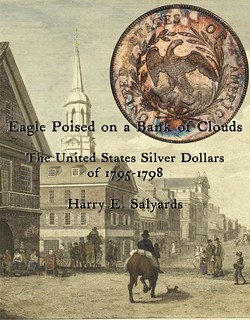 Long regarded as a key early Federal
Long regarded as a key early Federal type
coin, the Draped Bust / Small Eagle dollar has been
subject to more than its fair share of unfounded speculation and mythmaking. In this book the
author separates fact from fiction. He refutes the assertion that the Early Dollars of the United
States were deficient in silver, uncovers the real reason for their export to the Caribbean in the
1790s (clarifying the real nature of the oft-quoted exchange
for Mexican 8 Reales), refutes
the myth of Gilbert Stuart's involvement in the Draped Bust design—giving credit, instead, to
John Eckstein, whose 3-dimensional wax models were the basis for Robert Scot's designs of
October 1795—and presents reliable evidence, in the form of actual PCGS population counts by
variety, of the surviving numbers of each—totals significantly lower than those proposed by
Bowers in 1993. A suggested total mintage for the series is similarly calculated, and the change
to the Heraldic Eagle reverse is put into the historical context of the undeclared war with
France in the spring of 1798. An updated list of the finest known examples is presented for each
die marriage, and all major die states are illustrated for the first time. Finally, he has provided a
Collecting Quality
feature for each variety, suggesting ways in which the knowledgeable
collector may assemble an impressive array of these truly rare coins without spending a fortune
in the process. These pieces are written in the spirit of his Editor's Introductions to Penny-Wise,
for which he has received multiple awards from the Numismatic Literary Guild.
A member of the Rittenhouse Society, editor of Penny-Wise since 1986, and a charter member of the John Reich Collectors Society, the author's fascination with the Early Dollars of the United States began when asked by Dave Bowers to help edit his Silver Dollars and Trade Dollars of the United States (1993). Following his retirement, after 34 years as a practicing family physician (2011), he was able to delve more deeply into the history and iconography of these impressive coins. This book, seven years in the making, is the result.
Hardbound in blue cloth, Smythe-sewn binding, lettered in gilt, with a dust jacket, 288 pages, extensively illustrated in color on glossy paper. Available from the author for $145 postpaid.
P. O. Box 1691
Hastings, NE 68902
hesalyards@gmail.com.
NEW BOOK: TREASURE COINS 2022 ANNIVERSARY EDITION
A new book by Carol Tedesco discusses the treasure coins of the Nuestra Señora de Atocha and the Santa Margarita. -Editor
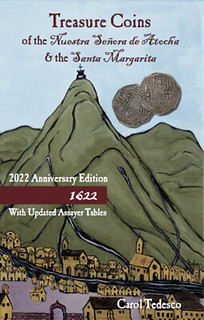 Treasure Coins of the Nuestra Señora de Atocha and the Santa Margarita, the 2022 Anniversary Edition, provides detailed information about the silver reales
Treasure Coins of the Nuestra Señora de Atocha and the Santa Margarita, the 2022 Anniversary Edition, provides detailed information about the silver reales treasure
coins recovered from Florida's 1622 fleet shipwrecks, including what the coins look like when first discovered, how they are cleaned, conserved, and graded, what they were worth in the 17th century, the meaning of the various markings, how to identify a coin's mint of origin, and the names and periods of office of the assayers who were responsible for guaranteeing coins of legal weight and purity and whose initials were mandated to be stamped on them. The 2022 edition significantly expands on the 2010 edition, with added back-stories on the founding of the minting houses, more historic images, and the most current assayer identity and timeline information available to date for the Potosi, Lima, and Mexico City mints, from their openings up until 1622, including extensive source citations.
Review:
As a foremost authority on Spanish Colonial coinage from the lost 1622 Tierra Firme fleet, Carol Tedesco has provided an up-dated history of the mints and assayers represented on over 200,000 silver coins excavated from the Nuestra Señora de Atocha and Santa Margarita shipwreck sites. Her meticulous study stretching over the last three decades has been augmented by several prominent Latin American archival historian/numismatists who, in the spirit of advancing the body of knowledge, have contributed significant research data to fill in known gaps in the New World coinage. This numismatic "tour de force" is a major archaeological contribution in the documentation of the 1622 artifact assemblage, which tells a unique research story of underwater discovery to be enjoyed by history buffs, academic scholars, and numismatists around the world...
R. Duncan Mathewson III PhD
Marine Archaeologist
For more information, or to order, see:
TREASURE COINS OF THE ATOCHA AND MARGARITA ANNIVERSARY EDITION BY CAROL TEDESCO
(https://store.melfisher.com/collections/souvenirs/products/2022anniversarycaroltedesco)
TREASURE COINS OF THE NUESTRA SENORA DE ATOCHA & THE SANTA MARGARITA
(https://shipwrecktreasuresofthekeys.com/collections/merch-books/products/treasure-coins-of-the-nuestra-senora-de-atocha-the-santa-margarita-1)
NEW BOOK: UNTANGLING THE RECORD
A second book by Carol Tedesco discusses the Potosi and Lima Mint Coins. -Editor
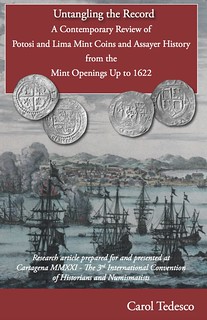 Untangling the Record—A Contemporary Review of Potosi and Lima Mint Coins and Assayer History from the Mint Openings up to 1622 is a second edition printing of a paper researched and written by Carol Tedesco and presented at Cartagena MMXXI —The 3rd International Convention of Historians and Numismatists, held in December of 2021 in Cartagena, Colombia.
Untangling the Record—A Contemporary Review of Potosi and Lima Mint Coins and Assayer History from the Mint Openings up to 1622 is a second edition printing of a paper researched and written by Carol Tedesco and presented at Cartagena MMXXI —The 3rd International Convention of Historians and Numismatists, held in December of 2021 in Cartagena, Colombia.
Description:
Some years previous to the discovery of the Atocha and Santa Margarita shipwrecks, a prominent expert in the field of Spanish Colonial numismatics incorrectly attributed the coins of early Potosi assayers R, M, L, and B to the Lima mint (and also C to La Plata), errors that were widely perpetuated for years by others citing his work. With the support of several of Latin America's most prominent archival historian/numismatists, Carol Tedesco has meticulously disentangled the evidence, deconstructed the errors, and updated the record, providing the most current assayer identity and timeline information available today, complete with extensive source citations.
Untangling the Record also explains the source of previous identity misattributions concerning a 1618 Potosi mint assayer using the monogram PAL, as well as the source of the lore behind assayer T - Juan Ximénez de Tapia - being labeled as "the dyslexic mint worker."
Carol Tedesco bio:
Carol Tedesco is an internationally recognized Spanish Colonial coin expert and historic shipwreck professional who specializes in designing relational databases specific to individual shipwreck projects. She has curated tens of thousands of coins and is considered a foremost authority on silver coins of the 1622 fleet. Other publications include Treasure Coins of the Nuestra Señora De Atocha & the Santa Margarita
(SeaStory Press 2010 and 2022 second edition), several shipwreck artifact archaeological mystery articles, and the academic paper, The Deep-Sea Tortugas Shipwreck, Florida: The Silver Coins,
from the Oceans Odyssey 3
compendium, (Oxbow Books, Oxford, UK). Carol is a founding member of the International Conventions of Historians and Numismatists.
Review
The fruits of the 3rd International Convention (of historians and numismatists) are beginning to germinate with important research and publications such as the book A Contemporary Review of Potosi and Lima Mint Coins and Assayer History from the Mint Openings up to 1622
, written by our researcher friend Carol Tedesco, who through a wonderful and meticulous work shares with us important numismatic events of the Potosi and Lima coins minted up to 1622.
Ing. Andrés Cortázar M
PRESIDENTE DEL COMITÉ
CARTAGENA 2021
For more information, or to order, see:
UNTANGLING THE RECORD
(https://store.melfisher.com/collections/souvenirs/products/untangling-the-record)
UNTANGLING THE RECORD - A SECOND EDITION PRINTING BY CAROL TEDESCO - A CONTEMPORARY REVIEW OF POTOSI AND LIMA MINT COINS AND ASSAYER HISTORY FROM MINT OPENING UP TO 1622
(https://shipwrecktreasuresofthekeys.com/collections/merch-books/products/untangling-the-record)
IAPN BOOK NOMINEE: NUMISMATICS FOR EVERYONE
Last October, Steve Woodland reviewed Serge Pelletier's new book Numismatics for Everyone. This announcement from Lighthouse Publications notes that it has now been short-listed for IAPN book of the year. Congratulations. -Editor
Pelletier's Numismatics for Everyone short-listed for International Association of Professional Numismatists' Book of the Year Award
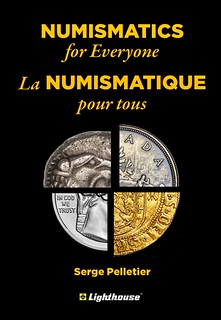 Serge Pelletier's Numismatics for Everyone = La numismatique pour tous has been short-
listed for the prestigious Book of the Year award of the International Association of Professional Numismatists
Serge Pelletier's Numismatics for Everyone = La numismatique pour tous has been short-
listed for the prestigious Book of the Year award of the International Association of Professional Numismatists
(IAPN). It is one of the 15-20 books that will be considered by the members of the IAPN at the upcoming general assembly in June.
Since 1982, the members of IAPN have been awarding the title of Book of the Year
to a book published on
numismatics during the previous year. Past winners include:
- DELZANNO, Roberto. Sveriges Guldmynt 1512-2020.
- STEVENS, Paul, The Coins of the English East India Company: Presidency Series. A Catalogue and Pricelist.
- MANVILLE, H.E. Tokens of the Industrial Revolution 1787-1828.
- SCHER, Stephen. The Currency of Fame. Portrait medals of the Renaissance
Copies of each book are exhibited at the Assembly so that delegates may familiarise themselves with them prior to
the vote,
explained Peter Preston-Morley, Chair of the IAPN's Publication Committee. The winning author is then
invited to receive his or her prize, a cash award, together with a winner's medal and a diploma, at a reception later
in the year.
To be short-listed for such a prestigious award is an honour in of itself,
said Serge Pelletier, the author, especially
since the book was nominated by a member of the IAPN.
For more information on the IAPN consult its website at https://iapn-coins.org.
For more information on Pelletier's book or to order it visit https://www.lighthousecanada.ca/numismatics-for- everyone-by-serge-pelletier.html.
To read earlier E-Sylum articles, see:
IAPN BOOK PRIZES 2021, 2022
(https://www.coinbooks.org/v25/esylum_v25n23a07.html)
BOOK REVIEW: NUMISMATICS FOR EVERYONE
(https://www.coinbooks.org/v25/esylum_v25n43a06.html)
CANADIAN COLLECTOR BILL ENGLISH TURNS 100
Ontario Numismatic Association President Sean Sinclair passed along this message about the 100th birthday of Bill English. Thanks, Happy Birthday! -Editor
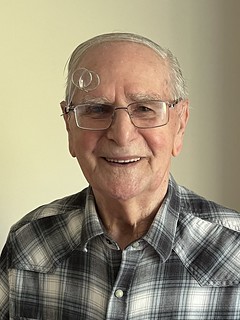 On Saturday, February 4, 2023, Mr. Bill English, a founding member of the ONA, Waterloo Coin
Society, and active member of both, turned 100 years old. In celebration of this
extraordinary man, who is an integral part of both clubs, the ONA, in cooperation with the family,
hosted a special birthday gathering on Sunday, February 5, 2023.
On Saturday, February 4, 2023, Mr. Bill English, a founding member of the ONA, Waterloo Coin
Society, and active member of both, turned 100 years old. In celebration of this
extraordinary man, who is an integral part of both clubs, the ONA, in cooperation with the family,
hosted a special birthday gathering on Sunday, February 5, 2023.
The event was held in conjunction with the Paris Coin Show, held at the Paris Fairgrounds, 139 Silver Street, Paris, Ontario. Many people dropped by, wished Bill happy birthday, and signed the guest book. There were photographs of Bill through the years, both with his family and his numismatic family.
Bill has received a lot of attention over the last year or so. In 2022, he was featured on the 60th Anniversary Convention Medal of the ONA, and beginning in January, his portrait was included on the $5 Souvenir Treasury Note from the Waterloo Coin Society.
Howard R. Engel of Richard Stockley Books writes:
"Thanks for this wonderful and oh-so-appropriate tribute to a true mensch and mentor to many (and counting!) numismatists in Canada and beyond. It is especially noteworthy that Bill is receiving these well-deserved honours from his peers, friends and admirers while he himself is still very much alive. Kudos to all those who were involved in putting this special numismatic tribute together, especially his home club of the Waterloo Coin Society. How cool it must be for him to see his endearing image and beatific smile on such well-designed commemorative medals and scrip!
"I love the singular way Bill shares his passion for the hobby. Besides his well-documented selfless years of service to organized numismatics and other collectors, one has not attended a coin show without Bill English pressing into your palm some collectible token of his esteem and friendship. As a personal example, my first Bill English "palm-pressing token" was at the RCNA Convention in Mississauga in 2014 when I first met him. It is of the sizeable 40 cm aluminum Kitchener-Waterloo, Ontario Canada 1969 Heritage Festival on the obverse and, "Double Good Luck" with love bird effigies on the reverse.
"Of course, I cherish this ex-Bill English token of friendship to this day. Thanks to Bill for all the love he has shown for the hobby of numismatics and for the innumerable collectors he has touched with his gentle presence over many decades of selfless service. What a great example of generosity and good will! May we all be inspired to "pay it forward"..."
Howard adds the following from a personal communication he received on Feb. 1 from Judy Blackman, a longtime friend and mentee of Bill English whom she got to know through their mutual membership in the Waterloo Coin Society. -Editor
"Bill sat on the committee responsible for the KW Oktoberfest medals (before the switchover to trade dollars), and he was on the committee responsible for the Heritage Festival medals. Bill designed the 1972 Canadian Numismatic Association (later RCNA) medal which was featured in Coin World. Bill had some of the Oktoberfest and Heritage Festival medals left over, and often would gift these at ONA and RCNA conventions to collectors. He put them in little blue jewellers' boxes with cotton and would tie them with a ribbon."
For more information on the Ontario Numismatic Association and the Waterloo Coin Society, see:
https://www.the-ona.ca/
https://www.waterloocoinsociety.com/
2023 NEWMAN GRANT PROGRAM ANNOUNCED
Applications are being accepted for the 2023 Newman Grants from the Eric P. Newman Numismatic Education Society. Here's the press release. Previous recipients have made excellent contributions to numismatic research. What great project do YOU have in mind? -Editor
Eric P. Newman Numismatic Education Society Invites Applications for Newman Grants
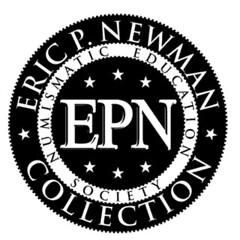 The Eric P. Newman Numismatic Education Society (EPNNES) announces the opening of the application
period for the 2023 Newman Grant program. Newman Grants are designed to financially assist
numismatic authors and organizations pursuing original research in American numismatics. This
program was launched in 2019 and supports research projects related to colonial numismatics, U.S.
federal coinage, counterfeit detection, and other areas.
The Eric P. Newman Numismatic Education Society (EPNNES) announces the opening of the application
period for the 2023 Newman Grant program. Newman Grants are designed to financially assist
numismatic authors and organizations pursuing original research in American numismatics. This
program was launched in 2019 and supports research projects related to colonial numismatics, U.S.
federal coinage, counterfeit detection, and other areas.
Authors, researchers, and numismatic organizations are encouraged to apply for amounts between $1,000 and $5,000. Awards may be applied toward related research costs including but not limited to photography, reproduction of research material and graphic art services, database access fees, and travel. Electronic publications will be preferred as EPNNES wishes to direct funds toward expenses specifically related to numismatic research, rather than the print publication of research. Newman Grant awardees agree to non-exclusive publication of their research on the Newman Numismatic Portal (NewmanPortal.org). EPNNES intends to make approximately half a dozen grants in 2023.
The Newman Grant program is administered for EPNNES by the Newman Numismatic Portal (NNP). Applications may be found on the Newman Numismatic Portal at https://nnp.wustl.edu/library/archivedetail/530553?Year=2023 and should be submitted to NNPCurator@wustl.edu. The application deadline is April 15, 2023, with the grant awards to be announced on May 25, 2023, coincident with the late Eric P. Newman's birthday. It is the hope of EPNNES that this program will continue the legacy of Eric P. Newman in a way that would reflect his high standards for numismatic research.
APRIL 2023 NNP SYMPOSIUM ANNOUNCED
The NNP Symposia are highlights of the numismatic year, bringing great speakers direct to you via Zoom. Be sure to plan for the next one, which adds an in-person option. Here's the announcement. -Editor
The Newman Numismatic Portal (NNP) Symposium is back for our next event with a new round of speakers this April! Sponsored by the Eric P. Newman Numismatic Education Society (EPNNES), the entire event remains free and virtual, open to anyone to attend. New this spring, you can also attend in person at Central States.
Whether virtual or in person, join us on April 27-29 for a great group of numismatic presentations.
WHAT'S NEW?
If you won't be attending the Central States show in Schaumburg, IL, nothing will change! Every presentation will be livestreamed on Zoom, and you'll be able to ask questions during the Q&A portion. We won't have any overlapping presentations this time, but nothing else will be different from past Symposia.
If you are planning to attend Central States, we hope you'll take the time to attend a few of our presentations. Every NNP Symposium presentation will be available in one room at the show. Some speakers will be presenting in person, while others will be presenting over Zoom and projected in the room. You'll be able to ask questions during the Q&A as well; our facilitators will handle balancing questions from both audiences.
You only need to register if you'll be attending virtually, though you're certainly welcome to either way. Only people who have registered will receive the schedule PDF with links to join the presentations, which is needed to attend virtually. There's no harm in registering if you plan to attend in person, but you're also welcome to just walk in.
If you have any questions or concerns, don't hesitate to contact us!
CAN I APPLY TO PRESENT?
We have a slightly smaller roster this time, and it's already almost full due to our cooperation with Central States. We may end up opening applications, but it's unlikely.
Regardless, rest assured that presenter applications will be open to the public again this fall. We'll have more slots available and hope to be able to accommodate everyone who's a good fit. We love being a home to new presenters and special interest presentations.
To register, see:
NNP Symposium Spring 2023
(https://www.eventbrite.com/e/nnp-symposium-spring-2023-registration-523961361537)
VIDEO: WALTER BREEN
The David Lisot Video Library on the Newman Numismatic Portal can be found at:
https://nnp.wustl.edu/library/multimediadetail/522852
We highlight one of his videos each week in The E-Sylum. Here's one from 1986 interviewing controversial hobby figure Walter Breen. -Editor
ANA Numismatic Personality: Walter Breen David Lisot, Interviewer.
Breen was a pioneering numismatic author and researcher, known for the award-winning (and still referenced today) Walter Breen's Complete Encyclopedia of U.S. and Colonial Coins. He was interviewed again in 1988 - see the links below for more information.
He wrote a letter to the editor of The Numismatist in 1950 concerning the Confederate Dollar restrike, and attended his first ANA convention 1952. He performed original research in the National Archives and knew Wayte Raymond, Stuart Mosher, and William Sheldon. He related the harrowing story of the time he was riding as Mosher had a heart attack while driving the car. -Editor
To watch the complete video, see:
https://nnp.wustl.edu/library/book/557357
To read the earlier E-Sylum articles, see:
CONFRONTING THE LEGACY OF WALTER BREEN
(https://www.coinbooks.org/esylum_v18n45a11.html)
READER COMMENTS ON WALTER BREEN
(https://www.coinbooks.org/esylum_v18n46a10.html)
VIDEO: WALTER BREEN INTERVIEWED
(https://www.coinbooks.org/v23/esylum_v23n23a10.html)
MORE MONEY ART: VICTOR DUBREUIL, PETER HIDE
Here's some more money art, beginning with images Tony Terranova submitted of two Victor Dubreuil works. Beautiful - thanks! -Editor
Tony adds:
"Those Dubriel barrel paintings are decorating the walls of a California coin and currency's dealers office. He collects that particular artist."
Above is the image from last week's article. Also this week I happened to come across this 2020 work by contemporary Italian artist Peter Hide. Here are images of the front and back of the piece, plus a closeup. Great new word (new to me, anyway) - "crumplage." -Editor
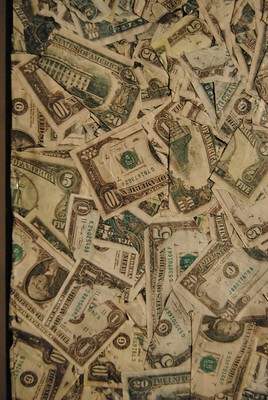 Peter Hide, artist also present at the 2017 Venice Biennale in the Tibet pavilion, was the first ever Italian artist, since 2003, to deal with banknotes in works of art.
Mixed technique with crumplage of banknotes (facsimile of American dollars) on canvas, entitled In God we trust, in its full and usual irony about the God of money.
Peter Hide, artist also present at the 2017 Venice Biennale in the Tibet pavilion, was the first ever Italian artist, since 2003, to deal with banknotes in works of art.
Mixed technique with crumplage of banknotes (facsimile of American dollars) on canvas, entitled In God we trust, in its full and usual irony about the God of money.
Single piece.
Dimensions 70 x 50 x 4.5 cm
Year 2020
To read the complete lot description, see:
Peter Hide (1965) - In God we trust - Crumplage
(https://www.catawiki.com/en/l/66231813)
To read the earlier E-Sylum article, see:
THE MONEY ART OF VICTOR DUBREUIL
(https://www.coinbooks.org/v26/esylum_v26n05a33.html)
NOTES FROM E-SYLUM READERS: FEBRUARY 5, 2023
Dansco Albums Wanted
Justin Hinh writes:
"I recently joined the NBS. I am a massive fan of Dansco albums and their history. I am creating a preservation project to collect one of each Dansco ever produced to preserve for future generations. Here is my current collection! I have been struggling to find certain albums and fellow NBS members seem perfect to know where I can find them"
The late David Lange would be thrilled with the project, and I encourage E-Sylum readers to help if they can. -Editor
Justin adds:
Readers can reach me at my email justintsn10@gmail.com or connect with me on Instagram and see more detailed posts from my collection: https://www.instagram.com/dansco_dude/.
To see Justin's collection:
https://imgur.com/a/qKX3K7D
To see his want list:
Buying: Odd, Foreign, Out of Print, or Custom Dansco Albums
(https://forums.collectors.com/discussion/1086346/buying-odd-foreign-out-of-print-or-custom-dansco-albums)
More Coins in Movies
Brad Karoleff writes:
"Do you have "The World the Flesh and the Devil" from 1959 on the "Coins in Movies" list? Harry Belafonte flips a Franklin half."
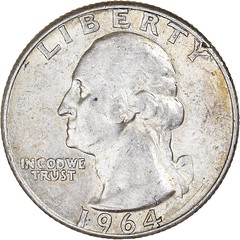
Never heard of that one! Thanks. I can also report that a significant plot point in the new Tom Hanks film "A Man Called Otto" hinges on a silver 1964 Washington Quarter. -Editor
To read earlier E-Sylum articles, see:
FEATURED WEB PAGE: COINS IN MOVIES
(https://www.coinbooks.org/esylum_v18n28a42.html)
COINS IN MOVIES: WILLY WONKA
(https://www.coinbooks.org/esylum_v09n04a27.html)
MOVIE MONEY: THE COINS OF ZAMUNDA
(https://www.coinbooks.org/v21/esylum_v21n14a37.html)
Contemporary Circulating Counterfeits Group Formed
John Lorenzo writes:
"A new Facebook group was created for Contemporary Circulating Counterfeits (CCC's) - the academia types (i.e., the good ones) to help people understand the difference between the historical types and current Chinese base metal junk. With all the bad news these bring I felt a new Facebook channel covering all the good ones from ancients to 20th U.S. Federal was needed. Currently myself, Jeff Rock (C4) and Winston Zack are Moderators. We are looking for an ancient expert to join this group. A large time frame from Ancients to Modern should bring some excitement or something different to the numismatic marketplace. In one day we were almost 50 members strong."
On the page the About section states "This group is about the study and discussion of good counterfeits of historical importance and termed contemporary circulating counterfeits." When I checked earlier today there were 78 members. -Editor
To visit the facebook group, see:
Contemporary Circulating Counterfeits (THE GOOD ONES!)
(https://www.facebook.com/groups/845348399902181)
1883 Railway Appliance Exposition Medal Information Sought
John Swindling writes:
"My name is John Swindling and I am 8 years old. I'm researching about the 1883 Railway Appliance Exposition, to learn more about an award medal. I found it listed in auction lots as Harkness Nat-220, but I don't have a copy of the Agricultural and Mechanical Society Award Medals of The United States book to see the medal on that page. Can anyone reading this help me out? Thanks for helping me with my research project!"
John's dad Jeff Swindling adds:
"We recently purchased a bronze medal from the exposition, and John is having a great time researching the old newspapers and advertisements that mention his medal and the company that won it! Thanks to fellow numismatist and train enthusiast George Cuhaj for starting us on this adventure!"
Great project. Who can help? -Editor
SANTO DOMINGO MMXXIII CALL FOR PAPERS
Augi Garcia passed along this announcement from the Sociedad Numismática Dominicana (Dominican Numismatic Society) about the upcoming Santo Domingo 2023 International Convention of Historians and Numismatists. Thank you! -Editor
4th International Convention of Historians and Numismatists announces call for research papers
The 4th International Convention of Historians and Numismatists—Santo Domingo MMXXIII—set to be held from June 28 through July 2, 2023, in Santo Domingo, Dominican Republic, has announced a call for research papers.
Papers must be previously unpublished and address Ibero-American or World numismatic history, including coins, medals, banknotes, bonds, tokens, oaths, and vouchers, etc., and may be submitted in English or Spanish.
Deadline for submission of proposals is February 15, 2023. Notice of accepted paper proposals will be announced by Academic Committee President Andrés Felipe Cortázar and committee members Jorge Proctor, Richard Caccione, Ulises Gardoni, and Andrés Langebaek on March 15, 2023. Deadline for submissions of completed papers is April 15, 2023.
The biennial International Convention of Historians and Numismatists (ICHN), launched with Potosi 2016—the 1 st International Convention of Historians and Numismatists—and followed by Arequipa 2018, and Cartagena MMXXI, is widely recognized as the most representative and prestigious numismatic event in Latin America, bringing together the most important researchers, collectors, associations, and numismatic companies from more than twenty countries on three continents. Events feature presentation of previously unpublished research, lectures by prominent researchers, book releases, commercial tables for sellers and collectors, cultural excursions, and both formal and informal social events.
For complete research paper submission guidelines, email Andrés Felipe Cortázar at acortazar@numiscol.com. For event registration email sonumisdom@gmail.com. For more information visit the Santo Domingo 2023 Facebook page and www.santodomingo2023.com.
ICHN conventions are traditionally held in host cities that were once headquarters for historic minting houses. Here, some presenters and attendees of Potosi 2016—the 1 st International Convention of Historians and Numismatists—are pictured in the courtyard of the Casa Nacional de Moneda de Potosi.
ICHN attendees have the opportunity to attend presentations given by some of the most prominent numismatic experts in the world. ICHN is now accepting proposals for papers for the upcoming Santo Domingo MMXXIII – the 4 th International Convention of Historians and Numismatists.
Andrés Cortázar, Academic Committee President for Santo Domingo MMXXIII, and President of the organizing committee for Cartagena MMXXI welcomes Cartagena event attendees in 2021.
A Commemorative Medal design competition has also been announced. -Editor
Organizers for the 4th International Convention of Historians and Numismatists—Santo Domingo MMXXIII—have announced a call to artists interested in submitting a design rendering for this year's Commemorative Medal design competition.
The competition is to be juried by a Santo Domingo MMXXIII Commemorative Medal Design Commission, a group of five prominent numismatists individually selected by Jose Manuel Henriquez and Daniel Oropeza Alba, Presidents of the Organizing Committee for Santo Domingo MMXXIII. Commission members are: President, Miguel Estrella, Dominican Republic; Jorge Madonna, Argentina; Raúl Tapia,Bolivia; Oswaldo Rodrigues Jr., Brazil; and Augi Garcia, United States.
The competition is open to any person in the world with exception of the event's organizing committee and commemorative medal design commission. The winner will be awarded with the minting of their design and will receive a commemorateve medal minted in silver and a certificate of recognition. Contestants who rank second and third place will be awarded a special certificate. Deadline to submit is midnight February 15, 2023. For complete competition submission guidelines email: Santodomingo2023.medalla@gmail.com.
For complete competition information, email Miguel Estrella at Santodomingo2023.medalla@gmail.com. For event registration e-mail sonumisdom@gmail.com. For more information visit the Santo Domingo 2023 Facebook page and www.santodomingo2023.com.
THE BOOK BAZARRE
VOCABULARY TERM: MINT SET
Here's another entry from Dick Johnson's Encyclopedia of Coin and Medal Terminology. I added an image of a 1962 U.S. Mint set. -Editor
Mint Set.
A group of related coins, usually of different denominations of the same issue, packaged and sold by the mint that manufactured them or their sales agency. The packaging takes on a certain cachet that makes such set an official issue. The coins, any number from two upwards, are usually uniform as to finish or condition, most often of mint state (uncirculated). Thus mint sets differ from proof sets (see proof surface), and from assembled sets which can be the same issue coins but brought together at a later time. The coins in mint sets are usually of uniform toning in contrast to those in assembled sets (it is said that coins in assembled sets have not traveled the same road together
and therefore may possibly have different toned surfaces).
There are a number of mint set terms, these are:
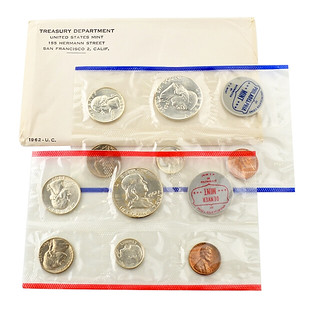 Special mint set, select mint set or specimen set. Coins for inclusion in the set are better than mint run specimens, care has been taken in selecting the best specimens available. Or some care may be given to either or both dies and blanks.
Special mint set, select mint set or specimen set. Coins for inclusion in the set are better than mint run specimens, care has been taken in selecting the best specimens available. Or some care may be given to either or both dies and blanks. Specimen set
was used by the Canadian Mint.
Souvenir mint set. A set issued by a mint which contains one or more special commemorative or souvenir coins in addition to regular issued coins.
Uncirculated mint set. Mint run coins sold by the mint or an assembled set, the only difference may be in the packaging.
A year set is not a mint set but is an ASSEMBLED SET which may or may not be privately packaged.
To read the complete entry on the Newman Numismatic Portal, see:
Mint Set
(https://nnp.wustl.edu/library/dictionarydetail/516331)
MORE ON JUNIOR COIN CLUBS
E-Sylum Feature Writer and American Numismatic Biographies author Pete Smith submitted this follow-up article on Junior Coin Clubs. Thanks! -Editor
Last week I asked about the first junior coin club. I still don't know the first but I know it was not my local club.
The first meeting of the New York Junior Numismatic Club was on February 19, 1924, with four prospective members present. Typical attendance was six. After two years the name was changed to the Long Island Numismatic Association. The club was active into 1932.
In 1925 there was a junior coin club associated with Central High School in Springfield, Massachusetts.
A Lowell High School Coin Club (of San Francisco) was mentioned in 1927. It did not last long.
A Central High School Coin Club (Washington) was mentioned in 1930 but was last mentioned in January, 1931.
There was a Buffalo Junior Coin Club in 1932. It was quickly out of business.
In 1933 there was discussion of forming several junior coin clubs in the Chicago area. The Chicago Junior Coin Club No. 1 was organized on December 5, 1933, with eight charter members. The Newman Numismatic Portal (NNP) has no mention of them after 1934.
The Junior Coin Collectors of San Francisco were organized on October 10, 1934. Their original advisor was Ernest R. Wernstrom. After his death in January 1938, Roy Hill became advisor. The club was disbanded in the summer of 1952.
There was a Brooklyn Junior Coin Club in 1934. It is mentioned only once in NNP.
Thus there were at least eight junior coin clubs that pre-dated the Northwest Coin Club. We know about them because they were mentioned in The Numismatist, Numismatic Scrapbook Magazine or some other hobby publication. Any number of other clubs may have existed without publicity.
Most of these did not thrive with their initial membership and were gone in five years.
Many collectors follow a typical pattern. They start collecting at age eleven and have enthusiasm but limited funds. That initial interest fades about age sixteen and goes dormant during college and child rearing years. The interest may be rekindled when free time and disposable income become available.
Has there ever been a successful college coin club? When I was in college, I attended a local coin club and was still in touch with some members twenty years later. That club was sustained by the adult members who educated and supported the younger members.
The Rochester Junior Numismatic Association is one notable success. It began on January 21, 1947, with forty-eight members aged 12 to 17. Founding advisor was Edward F. Meinhart. It benefited from a strong affiliated adult club.
What is the model for success? Can any E-Sylum reader describe their experience with a successful junior club?
Marc Ricard writes:
"The Rochester Junior Numismatic Association, Rochester, New York, was formed in 1947 by Edward F. Meinhart, the 31st President of the RNA. My father, Charles J. Ricard, was a charter member of the club, as well as many other future RNA Presidents. Along with Mr. Meinhart, many of the great RNA members at that time mentored young collectors in their collecting pursuits. Those collectors included George Bauer, John Jay Pittman, and Alphonse Kolb, to name a few. My father was 17 years old at that time, and he then joined the RNA on his 18th birthday. He credited his RJNA experience as the motivation to remain a collector and numismatist the rest of his life. At the time of his death in 2017, he was the longest serving member of the RNA, some 70 years.
The RJNA is active today, holding monthly meetings and the Meinhart Lecture Competition for Young Numismatists."
Great example of nurturing from a strong parent club. The University of Pittsburgh Coin Club was started by me, but after graduating in 1980 and leaving the city I lost that connection and didn't resume it on my return in 1984. The Western Pennsylvania Numismatic Society was strong in that period, but we didn't reach out to the University. Keeping a youth group going requires constant recruiting to replenish its ranks. Students graduate and go on to other things. -Editor
Julia Casey writes:
"I did some research into Pete Smith's question about junior coin clubs and found a report in the Numismatist, about the Buffalo Junior Coin Club that was associated with the Buffalo Numismatic Association. This Buffalo junior club was started in early 1932. I also found Buffalo newspaper notices that indicate some kind of junior club was established there in early 1930.
There is an article in the April, 1942 Numismatist by David S. Bingham, which mentions junior clubs and places the New York Junior Numismatic Club (later renamed the Long Island Numismatic Association) as the first. Bingham also makes mention of the Buffalo Junior Coin Club and says it failed for "lack of programs, leaders, new members and individual finance for coins" during the Great Depression.
I looked into the New York Numismatic Club and found reports in the Numismatist about the first meeting on February 19, 1924. When I researched the names of a few of the original members they seemed to be aged in their late teens and early 20s. Perhaps this is why the club decided to change their name just a couple years later - as the members quickly aged out of the junior level.
There is an interesting small file at the NNP containing Adolph Klein's correspondence with the ANS. Klein is noted to be the "Secretary and Treasurer" of the New York Junior Numismatic Club. The file indicates that Klein became a member of the ANS. He also applied for membership in the ANA in December 1923 (#2599)."
Thanks, everyone! -Editor
To see the original material on the Newman Numismatic Portal:
https://archive.org/details/Numismatist1936October/page/n55/mode/2up
https://archive.org/details/kleinadolph1923100amer/page/3/mode/1up?q=%22adolph+klein%22
To read the earlier E-Sylum article, see:
WHAT WAS THE FIRST JUNIOR COIN CLUB?
(https://www.coinbooks.org/v26/esylum_v26n05a15.html)
THE CELINA COIN COMPANY
Pete Smith also submitted this great article on the Celina Coin Company and its founders. Thank you! -Editor
Perhaps a good place to start the story of the Celina Coin Company is with the family patriarch, Edmund Hugo Brandts (b. 3/27/1879 d. 2/11/1932), a/k/a Emil Edmund Brandts. He was born in Gladbech, North Rhine-Westphalia, Germany and came to America on November 18, 1903, at age 24. He was a partner in the Mersman Brothers Brandts Furniture Company incorporated in 1906 in Celina, Ohio. He left the partnership to form the Celina-Maid Furniture Company and the Brandts Furniture Company.
Edmund married Lillie Mary Hirsch (1882-1959) on June 6, 1905. They had four sons and a daughter. All except the daughter are buried at the North Grove Cemetery in Celina, Ohio.
Edmund formed the Celina Realty Company with partners to develop property and build houses.
He owned property on Grand Lake that had cottages and tents for summer rentals. The Mercelina Hotel and restaurant were built on the property about 1911. His businesses failed during the depression and he died by suicide. His brief obituary stated he, died from the effects of gas fumes. He had been ill.
The first son was Edmund Hugo Brandts, Jr. (b. 11/22/1907 d. 2/8/1987) who was born in Celina, Ohio. He graduated from Babson College in Massachusetts, married Leah Kathryn Dull (1907-1981) on September 20. 1924, and had a son. After she died in 1981, he married Matilda Hare in 1982. He was a co-owner and manager of the Marcelina Hotel.
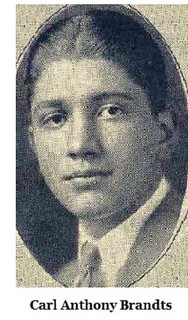 Second son was Carl Anthony Brandts (b. 11/28/1909 d. 12/9/1966), born in Celina, Ohio. He
married Anna Lee Fesker (1909-1958) on July 3, 1930. They had three children. He was a co-
owner of Marcelina Trailor Court and Marcelina Park. After 1949, Carl Brandts did not continue
with the coin company but went into business with the St. Mary's Heating and Plumbing
Company. His two sons were doctors. He died of a stroke at age 57.
Second son was Carl Anthony Brandts (b. 11/28/1909 d. 12/9/1966), born in Celina, Ohio. He
married Anna Lee Fesker (1909-1958) on July 3, 1930. They had three children. He was a co-
owner of Marcelina Trailor Court and Marcelina Park. After 1949, Carl Brandts did not continue
with the coin company but went into business with the St. Mary's Heating and Plumbing
Company. His two sons were doctors. He died of a stroke at age 57.
Third son was Theodore Conrad Brandts (b. 9/11/1912 d. 10/8/1948), known as T. C. Brandts. He married Ruth Jean Hoel (1912-2003) on September 21, 1935. He joined the ANA on June 1, 1941, as member 8525. He died of polio at age 36.
Fourth son was William Victor Brandts (b. 9/16/1914 d. 4/13/1942), born in Celina, Ohio. He married Julia Lenora Mastriana (1914-2001). He graduated from Ohio State University and was attending law school in June 1937, when he was injured in a truck rollover accident. A spinal injury left him as an invalid for five years before his death. He joined the ANA on February 1, 1942, as member 8860 about a year prior to his death at age 27.
If the Celina Coin Company had an infancy, it is not recorded. They advertised extensively in Numismatic Scrapbook Magazine beginning in February 1943.
The first ad in The Numismatist for the Celina Coin Company was in the March 1943 issue. Their address was given as the Mercelina Hotel in Celina, Ohio. This property was owned and managed by the Brandts family. The Celina Coin proprietors were T. C. Brandts and Carl Brandts. The ad offered pricelists on request. An April 1943 ad in The Numismatist listed T. C. Brandts without Carl. Another ad in The Numismatist for July, 1943, offered large cents and ran without the name of a proprietor. Their May 1944 ad had the names of Ted and Carl. In October 1944 they ran a two-page ad listing coins with prices.
They conducted a number of mail bid sales that probably include more that those listed in Gengerke, A public auction was held for the Ohio State Numismatic Society convention April 7, 1948, while Ted Brandts was still living. Their 1949 auction was conducted by new owner William Wilson. He conducted auctions into 1951.
The Newman Numismatic Portal includes records of invoices of coins sold by B. G. Johnson to Ted and Carl Brandts of the Celina Coin Company. They had access to great coins and were positioned to sell them through their store and mail bid sales. The death of Johnson on February 24, 1947, cut of that supply.
The Celina Coin Company was noted for handling rarities. Often mentioned is the 1870-S three- dollar gold piece, unique in collectors hands. The coin was in the Virgil Brand collection and handled by B. G. Johnson with the Brand estate. Johnson sold in to Ted and Carl Brandts for $7000 on Ted's birthday, September 11, 1945. They ran a full-page ad in The Numismatist in December 1945 and sold it to Louis Eliasberg for $11,500 in January 1946. In recent articles it was described as having a value of $10 million. When it sold at auction this January, it brought half that amount.
Following the death of Theodore Brandts in 1948, the company was sold to Robert Franklin Wilson (b. 1/18/1898 d. 3/28/1952). He joined the ANA in 1943 as member 9777. In 1949, Wilson relocated the company to 209-11 E, Market Street in Lima, Ohio. In 1945 he served on the U.S. Assay Commission. He served on the Lima city council 1945 to 1949. He had operated a sporting goods company and the Robert F. Wilson company as a mail-order company. He died of a stroke at age 54.
The Celina Coin Company was an important dealership briefly during 1943-48. The death of B. G. Johnson and unfortunate early death of Ted Brandts brought that to an end. Although the business was continued by Robert Wilson, it was diminished in importance.
A new Celina Coin Company LLC was incorporated January 19. 2016. Registered agent is Jordan Hayne. Their address appears to me to be a mail box at the UPS Store in Celina.
Julia Casey writes:
"I located some information about Ted Brandts of the Celina Coin Company, which helps to explain why the company had only a few years of intense activity during the mid-1940s. Theodore Conrad Brandts was stricken with polio and died in October 1948, at the age of 36. There is a family tree on Ancestry.com with a photo of him. His obituary listed his siblings and his widow Ruth, as well as his two children Conrad and Beverly.
"The November 1, 1948 edition of "Kelly's Coins and Chatter" on the NNP has a touching announcement of Brandts' death."
Very sad to read. Thank you for passing this along.
Here are a couple Celina Coin Company fixed price lists in my numismatic ephemera collection. Does anyone have more of these? -Editor
To read the Kelly's Coins and Chatter issue on NNP, see:
https://archive.org/details/kellyscoinschatt1n06kell/page/n1/mode/2up
To read the earlier E-Sylum article, see:
THE CELINA COIN COMPANY
(https://www.coinbooks.org/v26/esylum_v26n05a16.html)
BLAKE ALMA'S COINHUB
We've discussed other young dealers and social media feeds before, but I don't believe we've mentioned Blake Alma's CoinHub. Here's some background from a recent press release. -Editor
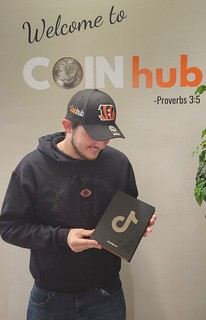 CoinHub is an online coin shop for coin collectors and enthusiasts. Collectors can sell and purchase their collections on CoinHub's website. CoinHub is based in Cincinnati, Ohio. It is the internet's most prominent social profile of coin collectors.
CoinHub is an online coin shop for coin collectors and enthusiasts. Collectors can sell and purchase their collections on CoinHub's website. CoinHub is based in Cincinnati, Ohio. It is the internet's most prominent social profile of coin collectors.
CoinHub was founded by 22-year-old Blake Alma when he was 19. Before being a social media personality, Blake was a television host, radio host, award-winning writer, and author. He has made it his mission to spread knowledge about the value of Numismatics among the people of his generation. This led to the creation of CoinHub.
Blake Alma is an award-winning writer, television personality, radio host, published author, and social media personality. He is the founder of CoinHub, with a TikTok and Instagram following of over 1,300,000 fans. Before becoming a numismatist, he was the editor-in-chief at Survivalist Daily. He hosted and produced The Outdoorsman's Art Radio Show and The Outdoor Experience on the Hunt Channel. His most acclaimed accomplishment was once being the youngest outdoor personality on television. Recently, Blake has used his social media following frequently to promote his coin collection and Christian faith.
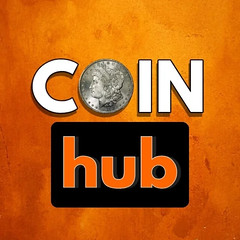 Blake Alma founded CoinHub in January 2020. Blake, under the inspiration of his mother, created a TikTok and Instagram page titling it CoinHub. Blake has produced dozens of videos regarding modern U.S. coin errors and their values. Within his first month, Blake accumulated more than 20,000 followers and 2 million video views on TikTok.
Blake Alma founded CoinHub in January 2020. Blake, under the inspiration of his mother, created a TikTok and Instagram page titling it CoinHub. Blake has produced dozens of videos regarding modern U.S. coin errors and their values. Within his first month, Blake accumulated more than 20,000 followers and 2 million video views on TikTok.
In August 2020, Blake posted a video about a Coca-Cola bottle cap coin produced in Fiji. The video got more than 250,000 views and tripled his follow count to 60,000. By October, CoinHub garnered more than 300,000 followers and 75 million video views on TikTok. In June 2022, Blake signed a partnership deal with WhatNot Inc to promote WhatNot's new coin auctioning platform. As of now, CoinHub has more than 1.2 million followers and 200 million video views. CoinHub currently has more than 850,000 followers on TikTok, 375,000 followers on Instagram, and more than 50,000 followers on Facebook.
To read the complete article, see:
YOUNG NUMISMATIST PROMOTES COIN COLLECTION TO THEIR GENERATION
(https://www.abnewswire.com/pressreleases/young-numismatist-promotes-coin-collection-to-their-generation_636809.html)
Young Numismatist Promotes Coin Collection To Their Generation
(https://www.benzinga.com/pressreleases/23/02/ab30717693/young-numismatist-promotes-coin-collection-to-their-generation)
NUMISMATIC NUGGETS: FEBRUARY 5, 2023
Here's a selection of interesting or unusual items I came across in the marketplace this week. Tell us what you think of some of these. -Editor
1797 Cheesemonger Counterstamp
1797 British Cartwheel Penny
Countermarked "R. SAVAGE / CHEESEMONGER / 28 WHITE CHAPEL"
The name is stamped in an arc.
Richard Savage was in business at this address in London during the 1830's.
Richard Savage, Wholesale Cheesemonger, 28 Whitechapel High Street, 1834-38.
Brunk S-143.
Scott 22.53 (p.81).
Where else would I have the chance to use the word "cheesemonger" in The E-Sylum? A neat counterstamp from the eBay offerings of Bob Merchant. -Editor
To read the complete lot description, see:
1797 British Penny, Counterstamp "R. SAVAGE / CHEESEMONGER / 28 WHITE CHAPEL"
(https://www.ebay.com/itm/134429526868)
1814 Russia Alexander Jeton
1814 Republic of Germany Counter Token Alexander I Medal: Obverse of Emporer Alexander I of Russia. Counter token with wear.
Interesting piece I'd never seen before. -Editor
To read the complete lot description, see:
1814 Republic of Germany Counter Token Alexander I Medal
(https://www.danajtharpauctions.com/1814_Republic_of_Germany_Counter_
Token_Alexander_I-LOT12984.aspx)
Confederate Half Dollar Restrike
*** Fully struck Confederate Half Dollar has full, sharp and raised Liberty. Great luster and eye appeal for this historic and popular issue. 340402 (FP) ***
A nice example of the Scott restrike using a planed-down genuine 1861 half dollar struck with the Confederate Half Dollar reverse die. From the online inventory of Harry Laibstain Rare Coins. -Editor
To read the complete item description, see:
1861 50C CSA RESTRIKE *** PCGS MS63
/a>
(http://hlrc.com/Inventory/CoinViewer?id=871080002&c=23)
Jamaica Street Car Co.Token
JAMAICA. Jamaica Street Car Co. 1 Fare Token, ND (1876). PCGS MS-65.
Prid-140. Struck in aluminum.
Estimate: $40 - $80.
Provenance: From the David Sterling Collection.
Nice transportation token, but where is it from? New York City? From the Stack's Bowers February 2023 World Collectors Choice Online Auction. -Editor
To read the complete lot description, see:
JAMAICA. Jamaica Street Car Co. 1 Fare Token, ND (1876). PCGS MS-65.
(https://auctions.stacksbowers.com/lots/view/3-114OYL/jamaica-jamaica-street-car-co-1-fare-token-nd-1876-pcgs-ms-65)
1913 Henri Salmet Aviation Medal
GREAT BRITAIN. Enameled Silver Presentation Medal in Wood Stand, 1913. EXTREMELY FINE.
Dimensions: Approximately 110mm x 76mm. Hallmarks: Walking lion (sterling), letter "O"(1913), anchor (Birmingham), and D.G.C (Daniel George Collins). Allegorical woman, left, facing right with extended left arm offering wreath of victory. Monoplane in flight at upper right, another on ground between towers. Inscription along top and right PRESENTED TO MONS. H. SALMET BY A. LEON ADUTT. MAYOR OF MARGATE AS A MEMENTO OF A THREE DAYS MAGNIFICENT EXHIBITION OF FLYING AUGUST 1913. The silver plaque is pleasantly toned with light hues of silver and gold. A light scratch in the field below the outstretched arm is noted for completeness. The enamel is virtually complete; only the edge of the upper right canton shows some disturbance in the color. Henri Salmet was a famed French aviator who flew across Great Britain in an "Aeroplane Tour" sponsored by The Daily Mail in 1913 and 1914. A very historic and important piece of aviation history.
Interesting early aviation medal. From the Stack's Bowers February 2023 World Collectors Choice Online Auction. -Editor
To read the complete lot description, see:
GREAT BRITAIN. Enameled Silver Presentation Medal in Wood Stand, 1913. EXTREMELY FINE.
(https://auctions.stacksbowers.com/lots/view/3-1154HY/great-britain-enameled-silver-presentation-medal-in-wood-stand-1913-extremely-fine)
1929 $10 FIRST NATIONAL BANKNOTE VALENTINE NEBRASKA PCGS VERY FINE VF 25
Circulated/Uncirculated: Circulated
Denomination: $10
Type: Banknotes
Year: 1929
Certification Number: 46408595
Grade: 25
Certification: PCGS Banknote Grading
Valentine's Day is approaching. How about a nice Valentine, Nebraska National Bank Note for your special collecting someone? -Editor
To read the complete lot description, see:
1929 $10 FIRST NATIONAL BANKNOTE VALENTINE NEBRASKA PCGS VERY FINE
(https://live.myntauctions.com/online-auctions/mynt-auctions/1929-10-first-national-banknote-valentine-nebraska-pcgs-very-fine-vf-25-4672492)
HAMBLEDEN HOARD DECLARED TREASURE
Here's a happy group of metal detectorists celebrating their find of the "Hambleden Hoard" of medieval coins. -Editor
A group of amateur detectorists are celebrating after their unlikely find of 600 medieval coins was declared treasure.
The haul – believed to be the biggest found in decade – is worth £150,000.
Their finds – nicknamed the ‘Hambleden Hoard' – including 12 rare gold nobles from the reign of Edward III.
At an inquest last week at Beaconsfield Coroners Court, senior coroner Crispin Butler said the hoard met the criteria for treasure after reading a report by Dr Barrie Cook, a curator at the British Museum.
They heard how the men – more used to digging up shotgun shells and thimbles than treasure – had been astonished to find coin after coin from the hidden ancient hoard.
Over four days they excavated 627 coins – including the 12 ‘extremely rare' full gold nobles from the time of the Black Death.
The rest of the hoard – 547 silver pennies from the reigns of Edward I and II, 21 Irish pennies, 20 continental coins and 27 Scottish pennies from the reign of Alexander III, John Balliol, and Robert the Bruce – were more commonly found.
It will now be left for the museum to negotiate a settlement with the finders and landowners, none of whom was present at the hearing.
The face value of the coins would be a little over £6 in today's money but the estimates of their worth range as high as £150,000.
The find was made at an organised rally which was held on a field near Hambleden, a village recorded in the Domesday Book of 1086.
On the first day they found 276 silver coins and nine gold nobles, and all admit they barely slept due to excitement.
Over three days the team's hoard grew to 545 silver coins plus fragments, and 12 gold nobles.
To read the complete article, see:
Medieval coin haul worth £150,000 unearthed by amateurs is declared treasure
(https://metro.co.uk/2023/02/02/medieval-coin-haul-worth-150000-unearthed-by-amateurs-is-declared-treasure-18209613/)
EARLY TUDOR GOLD PENDANT FOUND
While not numismatic, this Guardian article describes an amazing metal-detecting find. Thanks to Pablo Hoffman for passing this along. Just in time for Valentine's Day, it's a heart-shaped early Tudor gold pendant. -Editor
Charlie Clarke had been metal detecting for just six months when he stumbled across what he calls his once in a lifetime – no, once in 30 lifetimes
, find. He was exploring a Warwickshire field, turning up junk
and about to call it a day, when a clear beep on his detector led him to dig to the depth of his elbow. What he saw there caused him to shriek like a little schoolgirl, to be honest. My voice went pretty high-pitched
.
What the Birmingham cafe owner had discovered was a huge and quite spectacular early Tudor pendant and chain, made in gold and enamel and bearing the initials and symbols of Henry VIII and his first wife, Katherine of Aragon.
When Rachel King, curator of Renaissance Europe at the British Museum, first heard about the discovery, she had to sit down. Nothing of this size and importance from the Renaissance period had been found in Britain for more than 25 years, she said.
The heart-shaped pendant, attached to a chain of 75 links and made of 300 grams of 24-carat gold, is decorated with a bush bearing the Tudor rose and a pomegranate, Katherine's symbol, and on the reverse the initials H and K. Ribbon motifs carry the legend TOVS and IORS, which King called a beautiful early English Franglais pun
on the French word toujours
and all yours
.
Despite initially seeming almost too good to be true, said King, careful scientific analysis has proved the pendant to be genuine. What experts have not been able to uncover, however, despite scouring inventories and pictures of the time, is to establish a personal link to Henry or Katherine.
Nonetheless, its quality is such that it was certainly either commissioned by or somehow related to a member of the higher nobility or a high-ranking courtier.
One hypothesis, based on careful analysis of its iconography and other historical records, is that the pendant may have been commissioned to be worn or even given as a prize at one of the major tournaments of which Henry was so fond, around the time of the famous Field of the Cloth of Gold in 1520. Though its size suggests it would only fit a woman, it may not have been meant to be worn at all.
Nothing remotely similar survives from the period, said King. In the British Museum, we've got the largest collection of objects from the early Tudor periods in precious metal; none of them are anything like this.
Pablo adds:
"Quite a change of fortune for the lucky pendant . . . buried in dirt for centuries, now reverently handled with surgical gloves."
To read the complete article, see:
Metal detectorist unearths Tudor gold pendant linked to Henry VIII in Warwickshire
(https://www.theguardian.com/culture/2023/jan/31/metal-detectorist-tudor-gold-pendant-henry-viii-katherine-of-aragon-warwickshire)
ANCIENT COIN COLLECTORS GUILD RESPONDS TO THREATS
Dan Sedwick passed along this Ancient Coin Collectors Guild article by Keith Twitchell about the latest regulatory threats to the hobby. -Editor
After watching the most recent meeting of the Cultural Property Advisory Committee, it's easy to draw the conclusion that coins – and coin collectors – are collateral damage in the battle over importation of culture and historical artifacts in general.
The Committee met in open session on January 30, 2023 to consider Memorandums of Understanding relating to proposed import restrictions on cultural goods with three countries: Cambodia, North Macedonia and Uzbekistan. The latter two would be new agreements, while the Cambodia proposal would extend and expand a current MOU. The meeting's purpose was to receive public input on these documents.
As proposed, all three are extraordinary in their scope, in time frame and types of items covered. Since this is not the forum for going into great detail, here is a very brief overview of the proposed agreements.
- Cambodia: depending on the type of artefact, the MOU would reach as far back as circa 2500 BC, and for some items, through 1891. Requested for inclusion in the new agreement are items made of stone, ceramic, glass, bone, wood, and metal, including coins. Architectural elements, manuscripts, and religious and funerary objects would be covered.
- North Macedonia: the proposed period for the agreement is 300,000 BC to the 1950s. Coverage is requested for archaeological items made from ceramics, stone, bone, ivory, glass, faience, and metal, including coins. Some specific items are listed, including musical instruments, pipes, mosaics, textiles, and artworks.
- Uzbekistan: maximum time frame is 50,000 BC to 1917. Materials include those in the two other proposals, along with plaster, stucco, unfired clay, birch bark, vellum, and shell, among others. Also included in this MOU would be human remains.
While there are important, legitimate issues relating to looting of archeological sites and illegal exporting of artefacts from each of these countries, the proposed MOUs are so vast in scope that they may well cause as many problems as they solve. That did not deter a number of individuals from testifying in their favor during the meeting. Speaking in opposition were Randy Myers on behalf of the Ancient Coin Collectors Guild and Peter Tompa, officially representing the International Association of Professional Numismatists. The American Numismatic Association joined the ACCG's written comments but was not present at the open session.
The majority of oral comments addressed only the MOU with Cambodia. Along with people speaking from an institutional vantage point, several individuals, primarily displaced Cambodian citizens, addressed the Committee. They spoke movingly of the damage to great, ancient structures, and to the subsequent damage to history and religion within Cambodia, that is caused by looting.
The institutional representatives addressing the Cambodia MOU tended to speak very generally, while in the process pointing out other as-yet untaken measures that would help solve the problems, and even acknowledging that the current MOU has been limited in its effectiveness. For example, Stephen Acabado, of the Society for American Archeology, pointed out that the lack of surveys and inventory listings of sites and items in Cambodia contributes substantially to the problem.
Tess Davis, the Executive Director of the Antiquities Coalition, freely acknowledged that looting and illegal exporting has continued despite the current MOU. Davis also stretched so far as to suggest that the MOU should be extended in order to protect potential buyers of these items in the United States.
The only person to speak in favor of the Uzbekistan proposal was Soeren Stark, a professor at New York University. Yet he also acknowledged that looting of Uzbek archeological sites has happened with the knowledge and silent consent of local authorities,
and that Uzbekistan has the legal framework to protect this local heritage.
In the process, he pointed out the need for local community education efforts to address these issues.
To summarize, several speakers identified actions that could be taken within these countries to address these problems. No one argued that the MOUs themselves would solve the problems, and there was even acknowledgment that the existing MOU with Cambodia has not deterred illegal looting and exporting.
Left completely unaddressed was the fact that these would be bilateral agreements, meaning that only importation of artefacts into the United States would be restricted. Illegal trade could continue in pretty much the entire rest of the world, meaning that even if the restrictions could be reasonably enforced (a major, separate issue), there would still be a vast market for these items. Meanwhile, legitimate collectors, dealers and institutions in the U.S. would be unfairly faced with onerous, confusing and inconsistent processes.
In countering these arguments, Myers cited the regional nature of coins and of the history of countries whose borders today do not match anything from any previous period of history. For example, North Macedonia is a new nation altogether, and there are legitimate questions as to whether coins were ever minted within its borders.
Tompa pointed out that the Convention on Cultural Property Implementation Act (CPIA), under whose aegis the MOUs are being proposed, requires correlation between where an item was made and where it was found. Very few coins are ever found where they were minted, since the definition of coinage is to be circulated via commerce. This is especially true of ancient coins; Tompa noted that Roman coinage served as world currency, and Roman coins have been found from England to Sri Lanka.
While Committee members had few questions for other speakers, CPAC member Anthony Wisniewski directed a number at Tompa, affording him the opportunity to elaborate on several key points, and to further distinguish coins from the other items covered in the proposed MOUs. Specifically, he noted that coins are not ethnographic objects
, whose protection is the purpose of CPIA. Tompa has written and spoken extensively on these issues, and those interested in the subject should read his considerably more detailed observations.
After observing the Committee meeting, it seems clear that if collecting ancient and world coins is to be protected from unnecessary restriction and overreach, coins simply must be distinguished from art, artefacts and antiquities. Coins are a category unto themselves. Their purpose was commerce; as such, they were intended to circulate over wide areas. They are not parts of physical structures, nor are they associated with religious and/or cultural heritage.
The ongoing trend is towards more, and broader, MOUs of this nature. That tide seems unlikely to turn soon, and if coins are not to be swept up in it, they absolutely must be separated out of the discussion to the highest possible degree.
Dan adds:
"We would like to see more press on the outrageous push to restrict importation of ancient coins into the U.S."
To read the complete article, see:
Coin Collectors Face More Collateral Damage as Cultural Property Advisory Committee Considers More Import Restrictions on Historical Coins
(https://accguild.org/news/13083575)
CHARLOTTE MINT UNDER CONFEDERATE CONTROL
A Stack's Bowers blog article by Chris Bulfinch discusses operations of the Charlotte Mint under the control of the Confederate States of America. -Editor
Coining operations did not immediately cease after the Confederate States of America seized the Charlotte Mint on April 20, 1861. Confederate troops occupied the building, turning it into a military headquarters and forcing employees to swear loyalty to the Confederacy or lose their jobs. The building hosted federal troops for a period during Reconstruction, and the facility later functioned as an Assay Office.
Experts think that 887 gold half eagles were struck in late May 1861 after the mint was seized. Unfortunately for collectors, these are indistinguishable from those struck under federal auspices. In our Spring 2023 Whitman Expo Auction, Stack's Bowers Galleries will offer an example of this historic date, pedigreed to the CAG Set of the Fairmont Collection.
The small mintage for the 1861-C half eagle, paired with significant collector demand for the historic date, makes it a desirable issue indeed. Roughly 200 examples are thought to exist, an estimate roughly borne out by the certified populations from both major third-party grading services.
Enhancing its desirability, the strike quality of 1861-C half eagles was superior in 1861 than it had been in either of the preceding two years, according to David Akers. Doug Winter concurs, writing in his book on Charlotte Mint gold coinage, The 1861-C is much better struck than either the 1859-C or the 1860-C half eagles. The obverse is fairly sharp with the exception of some weakness on the curls around the face. The curl below the ear is always weak. The top of the head is strong, as are the details on the bun. The first star is usually very flat while the rest are sharper with many showing full or nearly full radial lines. The border is sometimes weak from 3:00 to 6:00 with die crumbling noted on the denticles. I have seen some examples, however, with fully defined obverse denticles. The reverse is better struck than the obverse. Some have weakness seen on the neck of the eagle, but the overall level of sharpness is unmatched by any other of the late half eagles from this mint and is comparable to that seen on some of the issues from early 1850s.
Winter also points out that the coins entered circulation directly from the mint and circulated widely, which might explain the relatively large populations of lightly and moderately circulated examples in third-party grading services' censuses.
To read the complete lot description, see:
1861-C Liberty Head Half Eagle. Winter-1, the only known dies. Die State II. VF-35 (PCGS). CAC.
(https://auctions.stacksbowers.com/lots/view/3-112U2G/1861-c-liberty-head-half-eagle-winter-1-the-only-known-dies-die-state-ii-vf-35-pcgs-cac)
To read the complete article, see:
DID YOU KNOW THAT HUNDREDS OF 1861-C HALF EAGLES WERE STRUCK UNDER THE AUTHORITY OF THE CONFEDERATE STATES OF AMERICA?
(https://stacksbowers.com/did-you-know-that-hundreds-of-1861-c-half-eagles-were-struck-under-the-authority-of-the-confederate-states-of-america/)
HUNGARIAN LEVENTE MEDALS
An article by Bill Myers in the February 4, 2023 MPCGram discusses some medals of the Hungarian Levente. We're republishing it here with permission. -Editor
Hungary was restricted to an army of 35,000 after World War I and conscription was banned. To get around this Levente Associations were established in 1920 and levente loosely translate to will be a knight
. They were paramilitary youth organizations to promote physical and health training and run by military veterans. In 1939 it became mandatory for males aged 12 to 21 years old to join levente. It was comparable to the Hitler Youth but Levente was not openly fascist or overly politicized but were not free of political influences.
Levente became auxiliary military forces near the end of World War II. There were 1,300,000 members in January 1944. I have been unable to determine if they saw combat. There was also a Levente for females 12 to 19 years old that was formed in 1942 and was voluntary until October of 1944 but this was never implemented due to the Red Army approaching Hungary. Levente was disbanded on 17 March 1945 and any activist were convicted of anti-Soviet activities by a Soviet tribunal and sent to the USSR for penal labor.
There are collectible levente items which includes insignia and medals. I have acquired two medals. One has a left facing man with rifle on the obverse and the reverse has an oak branch and 1938 Megyei (county) II. I assume it medal for shooting. The other has a forward-facing runner on the obverse and an olive and oak wreath on the reverse with LEVENTENAP (levente day) 1944 II. DIJ (award).
I was not aware of this organization and it prepared the Hungarian youth for military service during World War II.
The MPC Gram is an email newsletter for collectors of Military Payment Certificates and other military numismatica. To subscribe to the MPC Gram, see: https://guide.us13.list-manage.com/subscribe?u=10eb366ab80344a56657e0d5d&id=58874b37e1 . -Editor
WWII MEDAL OF HONOR RETURNED
This heartwarming article and local news program video describe how a Virginia man was reunited with his father's Congressional Medal of Honor. -Editor
One man in Roanoke was finally reunited with his father's Congressional Medal of Honor after years of searching.
Imagine losing a family heirloom and never getting closer to finding it.
It is actually the only thing I have that represents my father,
said Bob Wilkin.
In 1946, at just 7 years old, Bob received the Congressional Medal honoring his father, Edward Wilkin.
General Omar Bradley presenting it to me, but what it really meant and what it represented,
said Wilkin. I never really understood it until I got older.
A year later he went away to military school and lost track of it.
Not really knowing whether it was stolen or if I had given it to somebody,
explained Wilkin.
Edward was killed in action while fighting during WWII. He was one of 473 soldiers recognized for their heroic actions and sacrifice.
In three days, he neutralized and captured six pillboxes single-handedly. Killed at least nine Germans, wounded 13, took 13 prisoners, aided in the capture of 14 others, and saved many, many American lives,
said Congressman Ben Cline.
Bob continued to search for decades - but never found the medal no matter where he looked. So he called Cline for help.
That is something our team does but this one was a little unique,
said Cline.
Cline's staffers asked the U.S. Army to replicate - something the Army said it couldn't do.
But that didn't deter them - they continued hunting and found it in Edward's hometown of Longmeadow in Massachusetts at the Longmeadow Historical Society.
Just reinforces to me what a great job they do each and every day for the citizens of the sixth district of Virginia,
added Cline.
77 years after it was first given to him, Bob got the medal back in Roanoke at Friendship where he now lives.
To read the complete article, see:
After 77 years, man reunited with father's WWII Medal of Honor
(https://www.wdbj7.com/2023/02/03/after-77-years-man-is-reunited-with-his-fathers-wwii-medal-honor/)
SPACEX ASTRONAUTS GET SPACE MEDAL OF HONOR
The Congressional Space Medal of Honor has been awarded to the two astronauts who piloted the first NASA SpaceX mission to orbit. -Editor
Two former NASA astronauts — Bob Behnken and Doug Hurley — were awarded the Congressional Space Medal of Honor on Tuesday. The duo ushered in a new era of space exploration when they flew to orbit aboard a SpaceX rocket in 2020, for the Demo-2 mission.
Vice President Harris presented the prestigious award to Behnken and Hurley during a ceremony at the White House.
This is the celebration of excellence,
Harris said. Today we welcome two American heroes to the White House. Through their ingenuity and bravery, they have helped America rebuild the bridge to orbit.
The award, which was created by Congress in 1969, is the highest honor an astronaut can receive and is presented to astronauts who have distinguished themselves by exceptionally meritorious efforts and contributions to the welfare of the Nation and of mankind,
according to NASA.
Previous awardees include Neil Armstrong, Alan Shepard and John Glenn. The last astronaut to receive this award prior to Behnken and Hurley was Bob Crippen in 2006. He served as the pilot for the first space shuttle flight, STS-1.
In total, the medal has been awarded 30 times, 17 posthumously to the crews of the Apollo 1, and Challenger and Columbia space shuttles.
Behnken and Hurley are receiving the award for their role in the Demo-2 mission, SpaceX's first human spaceflight mission. After NASA's space shuttle program ended in 2011, its astronauts had to rely on Russia as the sole means of transporting astronauts to and from the International Space Station.
To read the complete article, see:
Astronauts who helped ‘rebuild the bridge to orbit' awarded medals of honor
(https://thehill.com/homenews/space/3838337-astronauts-who-helped-rebuild-the-bridge-to-orbit-awarded-medals-of-honor/)
SHORT SNORTER EXHIBIT COMING TO PHOENIX
We've often discussed "Short Snorters" and the Short Snorter Project. Next month's ANA National Money Show in Phoenix will feature an impressive display of WWII short snorters. Here's the announcement. -Editor
The signature of President Harry S. Truman is in black ink to the left of George Washington's portrait on this World War II short snorter.
Visitors to the American Numismatic
Association 2023 National Money Show® (www.NationalMoneyShow.com) in Phoenix,
Arizona, March 2-4, can see the unprecedented, 64-foot-long display of short snorter
banknotes autographed by World War II-era dignitaries. The exhibit, courtesy of the
nonprofit Short Snorter Project (www.ShortSnorter.org), features over 300 signatures of
generals, admirals, presidents, prime ministers, and ambassadors.
This display of 140 historic banknotes will be of great interest to veterans and
collectors of militaria. It includes five complete sets of rare specimen-marked Allied
Military Currency,
said Tom Sparks, Founder of The Short Snorter Project.
The tradition of signing banknotes apparently began in 1925 with Alaska bush
pilots. The term short snort
was a slang expression for less than a full shot glass of
liquor, and short snorter
became a nickname for pilots who moderately enjoyed only a
small drink or two before flying. The autographs on the paper money were typically
obtained while the dignitaries or others were traveling together, usually in flight.
This unprecedented collection was assembled by United States Air Force Major
General Clayton Lawrence Bissell (1893 – 1972) and is now owned by former American
Numismatic Association President Jeff Garrett who is loaning it for the exhibit at the
ANA convention in Phoenix,
explained Sparks.
Future U.S. President, General Dwight D. Eisenhower, the Supreme Commander of Allied Forces in World War II, signed the back of this Series 1925-A $1 Silver Certificate.
According to Sparks, autographs on the notes include U.S. Presidents Herbert Hoover, Franklin D. Roosevelt and future President Dwight D. Eisenhower when he was an active duty General, as well as presidents of eight other countries. Prime Ministers' signatures include Britain's Winston Churchill.
This World War II 10 shillings short snorter
banknote from Australia is signed by General of the Army Douglas MacArthur, Colonel Oveta Culp Hobby who was the first Director of the Women's Army Corp, and actress Lana Turner.
In addition to Eisenhower, the many notable military leaders represented are
U.S. Generals James Doolittle, Douglas MacArthur, George C. Marshall, and George S.
Patton. Famous U.S. Admirals include William Bull
Halsey Jr. and Chester Nimitz.
The exhibit will be in booths 1120 – 1126 in Hall F of the Phoenix Convention
Center, 100 N. 3 rd Street in downtown Phoenix.
Sparks will conduct a Money Talks educational presentation about the collection,
The Short Snorter of Major General Clayton Lawrence Bissell, US Army Air Service,
at
3 pm on Friday, March 3, in room 154 of the convention center.
Public hours for the ANA 2023 Phoenix National Money Show are Thursday and Friday, March 2 and 3 from 10 am to 5:30 pm, and Saturday, March 4, from 10 am to 3:30 pm.
Admission on Thursday and Friday is $10 for adults. Children 12 and under as well as active duty and retired military personnel with valid ID with up to three guests are admitted free. Admission is free for everyone on Saturday.
The 64-foot-long exhibit of United States Air Force Major General Clayton Lawrence Bissell's 140 World War II short snorter
banknotes will be at the American Numismatic Association National Money Show in the Phoenix Convention Center, March 2 – 4, 2023.
Additional information about The Short Snorter Project is available at www.ShortSnorter.org and information about the American Numismatic Association National Money Show is available at www.NationalMoneyShow.com.
To read some earlier E-Sylum articles, see:
WHAT IS A "SHORT SNORTER?"
(https://www.coinbooks.org/v21/esylum_v21n45a27.html)
SHORT-SNORTER COLLECTION DONATED TO AIR FORCE MUSEUM
(https://www.coinbooks.org/esylum_v11n14a24.html)
LOST HAWAII SHORT SNORTER RETURNED TO FAMILY
(https://www.coinbooks.org/esylum_v18n35a23.html)
MARLENE DIETRICH's MASSIVE SHORT SNORTER
(https://www.coinbooks.org/v20/esylum_v20n39a25.html)
WOMEN ON BANKNOTES REMAIN RARE
Forbes magazine published an article on the presence of woman on banknotes around the world, warning that the passing of Queen Elizabeth could lead to multiple changes. -Editor
After the death of Queen Elizabeth II of England, who was featured on more banknotes than any other female by a long stretch, she might gradually disappear from them. Australia announced yesterday that the late queen will not grace new currency issues. While British territories or Commonwealth countries could decide to begin featuring the new British monarch, King Charles III, others—including Australia—will use the opportunity to move away from royal motives that could appear dated.
Women on banknotes still remain rare around the world and a phase-out of Elizabeth could be expected to decrease numbers even more. But an analysis of global banknotes shows that countries which begin to feature women are likely to continue doing so. Between 2016 and 2023, the number of independent countries that had women on their banknotes rose only by a handful to 46 as of February 2023. At the same time, eight countries that had already placed women on currency started to feature more.
Among the newcomers are Romania, now featuring a World War I heroine on the 20-Lei-bill, and Sierra Leone, which placed a trailblazing mayor and educationalist on the 20-Leones-bill, as well as Indonesia, Israel and Bolivia. Countries upping the number of women on their bills include Commonwealth countries that could soon stop to print banknote evergreen Elizabeth. Canada started to feature anti-segregationist Viola Desmond in 2018, while the Bank of England added author Jane Austen in 2017. Australia has actually featured four women other than Elizabeth on banknotes since the 1990s, while New Zealand and the Bahamas have currency depicting both Elizabeth II and a local female honorary.
More examples of women following women onto banknotes can be found in Latin America, where four countries feature three or more women each on their bills. The case of Mexico follows some typical patterns: In the 1970, the nun and writer Sor Juana Inés de la Cruz began to be featured on the country's currency. Women added to banknotes in the 20th century are indeed very often either religious heroines or artists, even though notable exceptions exist. During the 2000s and 2010s, the scope of which women were featured on currency generally widened. In Mexico, artist Frida Kahlo was added in 2010, while feminist Hermila Galindo and revolutionary Carmen Serdán followed in 2019. Peru also started out with a religious figure, saint Rose of Lima, on their new Sol currency in the 1990s, before historian María Rostworowski was added in 2021 together with two more women, Japanese-Peruvian painter Tilsa Tsuchiya and singer Chabuca Granda. Today, almost all countries in South America have women on their banknotes.
Female queens from England and antiquity
Currencies in Asia feature fewer women, but include some interesting and norm-defying entries. Kyrgyzstan for example features ballerina Bübüsara Beyshenalieva and stateswoman Kurmanjan Datka, who ruled a Kyrgyz khanate after her husband's assassination in the 19th century. The Philippines are not only the single country in the world depicting an elected female head of state, they have two on their banknotes: Former Presidents Gloria Macapagal Arroyo and Corazon Aquino. Eurasia and North Africa are the places where queens other than Elizabeth appear on banknotes. They are much more historical, however: Queen Tamar, co-ruler of Georgia in the 12th century, Palmyran Empress Zenobia from modern-day Syria and Queen Dido of Carthage in what is today Tunisia.
To read the complete article, see:
Women On Banknotes Remain Rare [Infographic]
(https://www.forbes.com/sites/katharinabuchholz/2023/02/03/women-on-banknotes-remain-rare-infographic/)
AUSTRALIAN CURRENCY WON'T FEATURE KING
Don Cleveland and Kavan Ratnatunga passed along this article on the Australian Treasury's announcement about a change to Australian currency now that Charles is King. One publication headlined their article "Aussies to chop monarch's head from banknote." -Editor
King Charles will not feature on Australia's $5 banknote following a decision by the Reserve Bank of Australia, prompting outrage from the opposition.
The portrait of Queen Elizabeth II first appeared on the $5 polymer note in July 1992 when the Queen celebrated the 40th anniversary of her accession.
Following the Queen's death, the RBA reviewed the design and on Thursday announced via a statement that the note would change, following consultation with the federal government.
"The Reserve Bank has decided to update the $5 banknote to feature a new design that honours the culture and history of the First Australians," the statement said.
"This new design will replace the portrait of Her Majesty Queen Elizabeth II.
"The other side of the $5 banknote will continue to feature the Australian Parliament."
However it is expected to be several years before the new note is in circulation.
Liberal senator Dean Smith, who is a staunch monarchist and constitutional conservative, said he did not understand why the note could not incorporate all elements of Australia's history.
"A design incorporating both our new King and an appreciation for Australia's Indigenous heritage and culture would be a better and more unifying approach," he said in a statement.
To read the complete article, see:
Australian $5 note redesign won't feature King Charles, as Queen Elizabeth portrait removed in update
(https://www.abc.net.au/news/2023-02-02/australian-5-dollar-note-queen-redesign/101920798)
Kavan adds:
"I wonder if Canada will follow Australia."
Thanks also to Dick Hanscom and Ron Guth for forwarding articles on the topic. -Editor
To read other articles, see:
Aussies to chop monarch's head from banknote
(https://www.businesslive.co.za/bt/business-and-economy/2023-02-05-aussies-to-chop-monarchs-head-from-banknote/)
Republicanism: Australia will honor indigenous cultures in its A$
(https://en.mercopress.com/2023/02/02/republicanism-australia-will-honor-indigenous-cultures-in-its-a-5-bill-instead-of-charles-iii)
Australia Banishes King Charles From Its Banknotes
(https://nymag.com/intelligencer/2023/02/australia-king-charles-isnt-fit-for-our-usd5-bill.html)
Britain ‘relaxed' about Australia omitting King Charles from new $5 banknote, high commissioner says
(https://www.theguardian.com/australia-news/2023/feb/03/britain-relaxed-about-australia-omitting-king-charles-from-new-5-banknote-high-commissioner-says)
THE BOOK BAZARRE
LOOSE CHANGE: FEBRUARY 5, 2023
Here are some additional items in the media this week that may be of interest. -Editor
A Stack's Bowers blog article by Chris Bulfinch discusses a nice Large Cent likely from the famous Nichols Hoard. -Editor
Mint State 1797 Sheldon-135 large cents are relatively abundant owing to the Nichols Hoard, a group of 1796 and 1797 cents owned by David Nichols. A resident of Gallows Hill in Salem, Massachusetts, Nichols in the late 19th century distributed a number of his accumulated cents to local young numismatists. The coins are thought to have originated with Benjamin Goodhue, kin to Nichols' wife, who served in the House of Representatives and Senate in the 1790s. Numismatic historians have not been able to confirm all the details surrounding the Nichols Hoard, but it is likely that this coin was part of it as S-135 is among the varieties identified in the hoard. Dozens of Mint State examples of S-135 are thought to survive.
To read the complete article, see:
STACK'S BOWERS GALLERIES TO OFFER S-135 REVERSE OF 1797 LARGE CENT IN SPRING 2023 RARITIES NIGHT SESSION
(https://stacksbowers.com/stacks-bowers-galleries-to-offer-s-135-reverse-of-1797-large-cent-in-spring-2023-rarities-night-session/)
This Greysheet article has more information on the recent sale of the Stewart Blay collection of Lincoln cents. -Editor
The finest collection of Lincoln Cents has been auctioned for $7,731,811 by GreatCollections, setting all-time world records including the first Lincoln Cent to break the million-dollar mark. 13 other Lincoln Cents realized over $100,000 each.
Blay, a sculptor from New York, was attracted to Lincoln Cents at eight years old. He spent decades traveling the country, visiting coin shops and shows on his quest for the very best, while also sharing his knowledge with fellow collectors and dealers. He consigned his core collection to GreatCollections several months ago and had expected to see the sales results before he unexpectedly passed away in late November, aged 71.
Ian Russell, president and co-founder of GreatCollections said, Stewart spent his life procuring the absolute best-of-the-best Lincoln Cents, and they were very well received by the market. Most of these coins were being auctioned for the very first time. It might be another generation before they appear on the market again.
To read the complete article, see:
Lincoln Cent Records Shattered with $7.7 Million Stewart Blay Collection at GreatCollections
(https://www.greysheet.com/news/story/lincoln-cent-records-shattered-with-7-point-7-million-dollar-stewart-blay-collection-at-greatcollections)
Nearly half of Americans have not written a single check in the past year, according to this article. I know I'm down to a precious few each quarter. -Editor
Although check writing was the primary means of monetary exchange in the 1980s, today the practice is hardly used. Compared to the instantaneous gratification of a quick Venmo or Zelle payment, checks are a much slower exchange of funds.
However, while this process is a slower form of payment, it is still commonly used today by landlords, contractors and real estate agents. Additionally, for people without internet access, having a checkbook is a necessity. Still, though writing a check remains a trusty method of taking care of expenses, this old-school technique is currently overshadowed by newer and faster online payment options.
According to a recent survey conducted by GOBankinrRates, 45% of Americans have not written a check in the last year. In light of this data, let's take a closer look to find out what alternative methods Americans are using to exchange money.
To read the complete article, see:
Almost Half of Americans Have Not Written a Single Check in the Past Year — Here's What They're Doing Instead
(https://www.yahoo.com/entertainment/almost-half-americans-not-written-120019202.html)
MYSTERIOUS ANCIENT COIN FOUND IN AUSTRALIA
Workers at a golf course in Australia discovered a mysterious corroded old coin. Can you identify it? Answer below. -Editor
When three golfers started repairing an old bench at Springwood Golf Course they never expected to uncover a wartime mystery.
During their repairs on the bench, found outside the golf course's pro shop, the three men discovered an old coin behind a memorial plaque.
The coin depicts ancient art and features intriguing dents.
Hoping to learn more, one of the men - Bob Blakemore - reached out to local veteran Greg Meek, a member of the Blue Mountains Vietnam Veterans Association.
Mr Meek believes the coin depicts the acropolis - and that the damaged parts of it could be from stray shrapnel.
"This seems to be... either a shrapnel or a bullet hole. So we don't know whether the coin was on his body and... stopped that penetrating his body, or what," Mr Meek said.
"You can get very tiny fragments of shrapnel, which could do that."
The coin has a smaller hole in the same place on each side, indicating it could have been worn around someone's neck, with the hole used to thread a string through.
The plaque which concealed the coin is dedicated to Sergeant George Cunningham.
About a month later, this follow-up article appeared. -Editor
The Gazette recently published an article on this corroded coin and plaque, detailing the life of the man commemorated and calling for submissions that could help identify the coin.
Since then Dianne Rutherford, curator of military heraldry and technology at the Australian War Memorial in Canberra, has formally identified the coin as a more recent Euro.
The image above shows a side-by-side comparison of the 10 Euro Cent coin and the coin found behind the plaque.
The Brandenburg gate is visible in both photos, along with the year 2002 at the bottom of both coins.
The Gazette would like to thank everyone who called or submitted emails to assist in identifying the coin and solving the mystery.
To read the complete articles, see:
Old coin hidden in a Springwood memorial shows acropolis and possible shrapnel marks
(https://www.bluemountainsgazette.com.au/story/8016772/mystery-of-coin-behind-plaque-on-golf-course-bench/)
Mystery coin from Springwood Golf Course identified
(https://www.bluemountainsgazette.com.au/story/8060934/mystery-coin-from-springwood-golf-course-identified/)

